STORIES

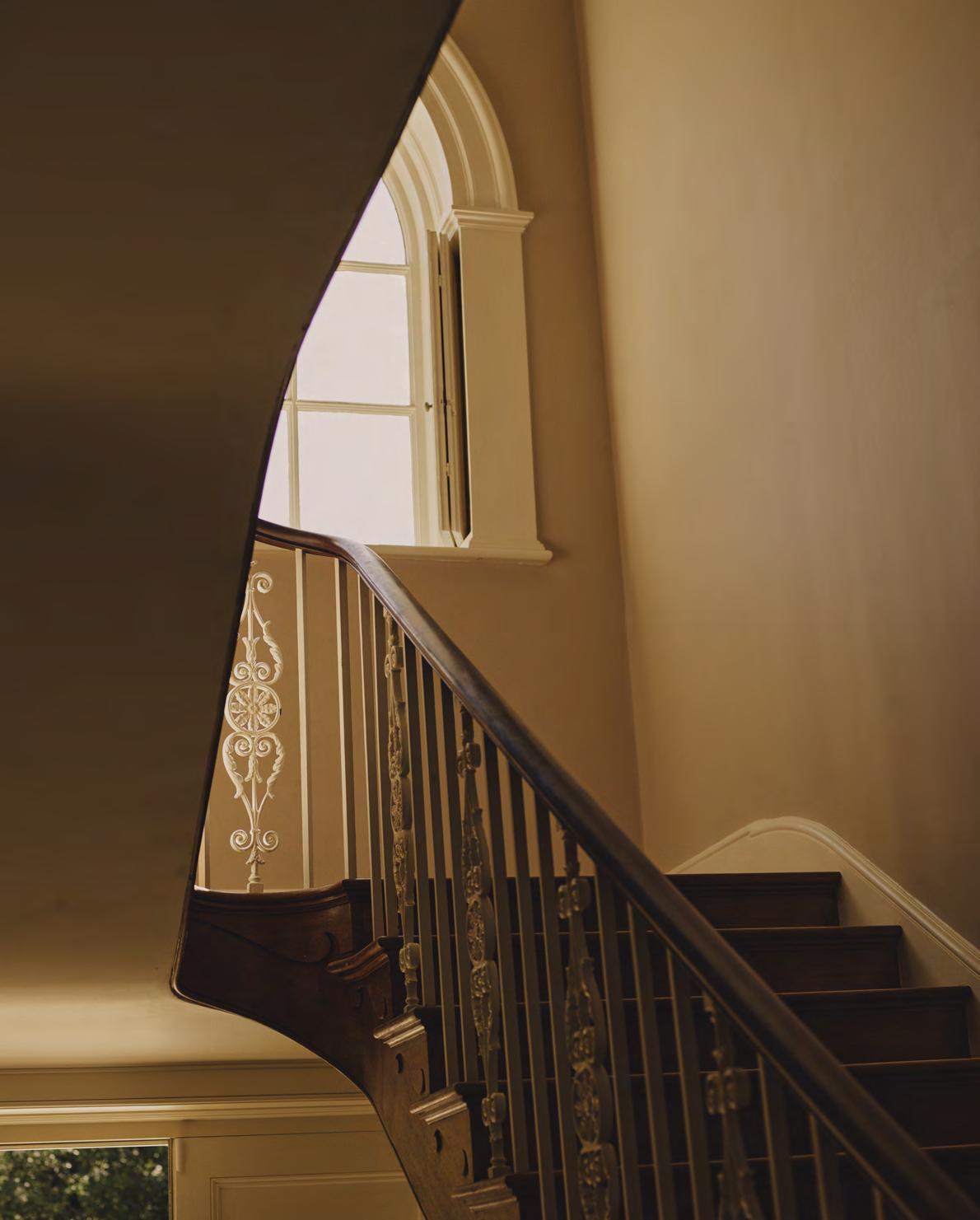



As we look towards our thirtieth anniversary in 2026, it feels like a good moment to review our journey so far. From our iconic designs like the Arundel table and Chichester dresser that have become synonymous with Neptune interiors, to our unique home-from-home stores, everything we do is considered. Added to this is our decision to establish our own factory which gives us total control over each detail of our making process. Our passion is to deliver the best products, services and experiences for our customers to make all our lives at home happier.
Underpinning this approach is our enduring connection to nature. We founded Neptune in a farm outhouse in Wiltshire, and the materials, colours and textures of the British countryside inform all we do. The tactility of brushed oak, a paint palette curated around the colours of the outdoors (including our new Saddle shade), and upholstery in pure cottons, linens and velvets: the beauty and comfort of the natural world inspires every collection.
In this edition of Stories, we explore how nature influences our homes in autumn. Well-designed boot rooms come into their own as muddy boots and paws become routine features of the daily walk; rooms wrapped in strong, enveloping colour introduce a cosy vibe to darker days; and recipes using root vegetables make delicious, seasonal dishes to serve by the fire. We’ve also highlighted some of the stand-out moments of the last 30 years in our potted history feature. As autumn arrives, we hope you enjoy this issue, and we look forward to welcoming you in store and online.

John Sims-Hilditch & Giles Redman Neptune co-founders
Thank you to the talented authors and journalists who contributed to this edition, along with our fabulous team of in-house writers.






Suzanne Imre
For many years, Suzanne Imre was the influential editor of interiors magazine Livingetc; a renowned style pundit and trend leader. Today, she works as a brand consultant, content director and writer. She lives in London and is always planning her next decorating project. @suzanne.imre
Merlin Hanbury-Tenison
Merlin Hanbury-Tenison is a conservationist and veteran who founded The Thousand Year Trust, Britain’s only rainforest charity, with the aim to triple Britain’s rainforest cover in the next 30 years. He has contributed to National Geographic, the Guardian and the BBC, and lives in Cornwall with his family.
@merlinhanburytenison
Giles Kime
Hampshire-based Giles Kime is executive editor of Country Life magazine and author of a number of books on leading designers, including Nina Campbell and Neptune’s creative founder, Emma Sims-Hilditch, all published by Rizzoli. His next book –on Kit Kemp – will land in spring 2026.
@giles.kime
Kassia St. Clair
Kassia St Clair is an author, cultural historian and broadcaster, and writes for The Economist and Architectural Digest. Her book, The Secret Lives of Colour, was BBC Radio 4’s ‘Book of the Week’. Her latest book, The Golden Thread, is published by John Murray Press.
@kassiastclair
Michelle Ogundehin
Michelle Ogundehin is a thought leader on trends, colour and style. She is the lead judge on the BBC Two/Netflix Interior Design Masters, and author of Happy Inside: how to harness the power of home for health and happiness.
@michelleogundehin
Photograph by Ben Anders
Preet Chandi
Preet Chandi MBE is an author, physiotherapist and former British army officer who recorded the longest ever, one-way, solo and unsupported Antarctic expedition in 2023. Her next challenge is to become the first female solo traveller to reach the North Pole, traversing flowing sea ice just to make the journey even more ambitious.
@polarpreet





Jo Rodgers
American-born Jo Rodgers is a journalist who lives in London and East Sussex with her husband and three children. She is a contributing writer at Vogue, Condé Nast Traveler, House & Garden, and Country Life.
@jo_rodgers
Ruth Guilding
Art and design historian Ruth Guilding is the founder and editor of the bibleofbritishtaste magazine. Her new book The Bible of British Taste, Stories of Home, People and Place, is published by Frances Lincoln.
@bibleofbritishtaste
Jessica Doyle
Jessica Doyle is design and interiors editor at the Telegraph, and has previously written for publications including the Financial Times, House & Garden, Country & Town House, and Homes & Gardens. She lives in south-east London with her husband and their two children.
@tjedoyle
Sarah Jane Bellmaine
Sarah Jane Bellmaine is The Provenist’s lead chef. She previously worked as head pastry chef for one of the UK’s top public schools, alongside running a successful luxury bakery company. She lives near Swindon with her husband and two children.
@chef_sarahjane
Harriet Thistlethwayte
Harriet Thistlethwayte is a photographer and writer living in Herefordshire where she grows vegetables and manages her four-acre garden. Through her Instagram account, she recounts her passions for living seasonally, growing flowers, and collecting old furniture.
@yomargey

WA desire to do the right thing for customers has steered Neptune for nearly 30 years, as co-founder John Sims-Hilditch tells editor Suzanne Imre.
hen John Sims-Hilditch and Giles Redman established Neptune in 1996, they immediately set out a clear purpose: to design modern classics, of lasting quality, at a fair price. This clear thinking soon led to writing their core principle which would guide everything the team did: to do the right thing (always, even when the customer doesn’t know). This original intention has endured to this day, influencing the type of materials used (never MDF or chipboard), the rigorous testing of cabinetry (even throwing a cabinet from a first floor to test its robustness in the early years) and a refusal to take short cuts in the production process.
‘Doing the right thing means acknowledging that “good enough” isn’t good enough,’ explains John. Like a sixth sense, customers can sense furniture that is superficial, rushed or not built to last. ‘Good design should hit you in the solar plexus. If we spot there are design improvement possibilities, then it’s the right thing to do them. It’s what has built us a loyal customer base. People know that furniture carrying our brand mark also carries the attention to every detail that we instinctively put into our designs.’
An example of such care is the regular inclusion of mortise and tenon joints with dowel locks that are often painted over, and thus invisible to the eye, but unlike furniture that is glued together, these traditional joints are designed to last for generations. Then there is the zig-zag shelving system which is difficult to do and requires extreme precision but is a beautiful and practical addition. Every Neptune cabinet has it.
Even the catches on cupboard doors are designed to offer the best possible experience. ‘When we began building cabinets, the doors needed decent catches, but we felt the ones available were rubbish, so we decided to make our own,’ says John. ‘We now have a range that draws on the concept of basic catches but engineered to a much higher standard with a jewel-like appeal. On the Chichester catch you can even adjust the tension with a small hidden screw depending on how firmly you want the door to close.’ Such care is why Neptune can offer its lifetime guarantee with confidence.
Doing the right thing by designing first class furniture at a fair price also impacts the customer’s buying experience. ‘All too often, a purchase is the best bit – the thrill of the kill,’ says John. ‘But from then on, the experience is downhill. We want our customers to have an increasingly good experience rather than a diminishing one, where they come to appreciate the quality of design and materials even more over time. It is why we set up our own manufacturing facilities and stores. Only by serving the customer from tree to table could we achieve the objective of creating enduring designs at fair prices. After all, we believe in doing the right thing.’


This is the
Turn heads with our new Cleo armchair – literally.
With a 360-degree swivel, this organically curved, deep-seated chair ‘floats’ on top of a hidden metal plinth base. It works seamlessly as an easy chair in a sitting room or a relaxing occasional chair in a bedroom.
Following a long line of noteworthy swivel chair designs (including the spindled Windsor chair adapted to rotate by Thomas Jefferson as he worked on the Declaration of Independence), our new Cleo is built around a robust tulipwood frame and is upholstered by hand, with a cushioned seat made from feather and fibre-wrapped foam for the ultimate in comfort and support.
Discover our full living collection, visit neptune.com/living

From royal refuge to architectural cornerstone, the oak tree is one of Britain’s most enduring natural icons. We explore how, as oak furniture makers, we are helping to protect its living heritage.
Not every tree can claim to have hidden a king. But then, the oak has always had roots deeply intertwined in British history. In 1651, its branches sheltered Charles II from the searching eyes of parliamentarian soldiers after the Battle of Worcester. It’s a scene so evocative its legacy endures not only in history books but also on pub signs across the country bearing the name ‘The Royal Oak’.
The oak tree has long been prized for its strength as a building material. Royal Navy ships were constructed from its timber until the middle of the nineteenth century, earning the fleet the nickname ‘the wooden walls of old England’. Oak has also played a role in architecture. It was, and remains, the most popular native hardwood used for the construction of timberframe buildings in England. The Tudors used it for structural beams that still hold strong today, while the Georgians used it to wrap their rooms in panelling.
This rich history has made the oak one of Britain’s most venerated trees. Its leaves and acorns form the
emblem of the National Trust, and, in 1987, its image appeared on the reverse of the pound coin. Another reason this timber feels so quintessentially British is that we are home to more ancient oaks than the rest of Europe combined. Protected under conservation laws, trees like the 800- to 1,000-year-old Major Oak in Sherwood Forest, are considered ecological and cultural living monuments.
As responsible timber furniture makers, we recognise the importance of preserving Britain’s oak trees. That’s why we support initiatives like Stump Up For Trees (SUFT), a charity working to plant and nurture mixed woodlands in the Brecon Beacons. By planting faster-growing species like birch and hawthorn alongside oak, SUFT provides the oak tree with shelter in its early years, enabling it to grow into maturity and thrive for generations to come.
In protecting the oak, we not only protect a native species, but a living heritage: a form of nature that has sheltered kings, framed homes, and formed furniture.

At Neptune, the oak tree is close to our hearts. It’s our go-to timber, especially for unpainted pieces like the Arundel dining table and Henley kitchen cabinetry. The oak we use is sourced from fully traceable, sustainable forests in the USA and Canada. We value it for its strength and natural beauty. Every plank tells its own story through its grain, colour, and pattern, bringing warmth and character into our homes. That’s why we created our IsoGuard® finish that protects oak without masking its natural beauty. As our co-founder John Sims-Hilditch says, ‘Oak has a long history in British furniture making. It’s incredibly strong but also naturally beautiful. I consider it a king among woods.’

As we look ahead to our 30th anniversary, it feels only natural to look back over the years and acknowledge the iconic designs that have become a part of our narrative. From our very first furniture collections to those steeped in the heritage of centuries past, these Neptune classics are more than just familiar favourites: they’re the embodiment of everything we stand for.

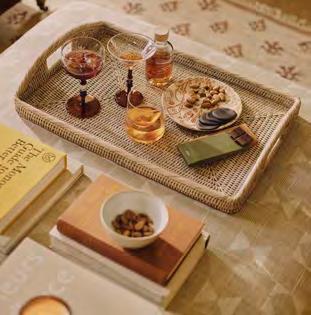
As popular today as when it launched, this Georgian-inspired dresser was the first piece designed by our co-founder John Sims-Hilditch as part of our original interior collection. In turn, it paved the way for many of the joinery and engineering techniques that have since become signatures, including our zig-zag shelving system – adjustable timber brackets that let you move shelves easily and support real weight. But it’s the dresser’s elegant proportions, enduring durability, and capacity to adapt – be it through a change in paint colour or hardware – that make it, in John’s words, ‘an antique of the future’.
Artisan-crafted designs have always had a place in the Neptune home, and Ashcroft – first introduced over a decade ago – remains one of our most enduring and beloved collections. Tightly handwoven by skilled artisans using natural, sustainable rattan, the Ashcroft tray is as strong as it is beautiful, with a double-layer base to give it extra sturdiness. The off-white enamel wash lets the natural rattan peek through in places, softening the look and lending a gently aged feel. It’s a subtle detail, but one that speaks to thoughtful artisan craft.
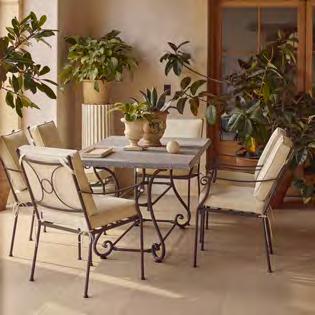

Cheltenham traces back to our origins, when our co-founders designed and crafted a hammock from scratch, laying the foundations for our garden collection. Since debuting as ‘Monaco’ in 2005, it has seen several elegant evolutions on its journey to becoming a perennial favourite. Just this year, it was reimagined with striped green cushions allowing customers to opt for a touch of colour too. Inspired by the ironwork of historic townhouse balconies, the decorative design is made from galvanised steel and granite that promise to withstand the elements for years to come.
Wander past our curated tablescapes, peer inside our glass-fronted cabinetry, or stop by our Provenist café, and you’re sure to spot the Ella tumbler. Simple and unfussy, these durable little tumblers celebrate the beauty in simplicity. Unique for the hundreds of tiny, trapped air bubbles that are formed during the making process, each mouthblown glass has a beautiful, dappled appearance. First introduced in the summer of 2014, the collection has been reimagined many times in an evolving palette of colourful hues, from soft Rose and crisp Apple to warm Saffron and deep Forest.

MATILDA CHAIR
Matilda reflects our commitment to quality upholstery that will last for generations. Born from a desire for a classic armchair with a compact footprint, it feels at home anywhere from bedroom to hallway. The solid tulipwood frame (which carries our lifetime guarantee) is expertly carved to shape the gently scrolling arms and fan-like back – a considered alternative to the common shortcut of foam wrapped around a basic frame. Upholstered by hand in your choice of fabric, it’s as versatile as it is timeless. Perhaps that’s why this understated icon has remained a firm favourite for so many years.

The newest name among these icons, Eliza, may have only launched just over a year ago but is already well on the way to future classic status. Its exposed oak frame and elegantly turned oak legs seamlessly combine comfort with considered details. Not one to be tucked away, this sofa was designed to be admired from all angles. It’s a concept that was inspired by an antique design unearthed by our design director, Fred Horlock, while researching period sofas at an auction house. The traditional silhouette has been thoughtfully adapted for twenty-first-century living with a pared-back aesthetic and deeper proportions, which invite you to sit back and relax.

Introduced to our dining collection in 2015, Arundel quickly claimed its place as a true Neptune classic. Inspired by the strength and grandeur of Arundel Castle, this refectory-style table is built from natural oak with a cross-bonded central panel that resists warping over time. It’s not standard practice in table making, but it ensures this table will form the heart of the home for generations to come. A-frame legs, exposed dowel-lock joints, and optional extending leaves also speak to its functional beauty. ‘Arundel has this fantastic, pared-back simplicity but a really striking architectural elegance too,’ explains co-founder John Sims-Hilditch.

Chawton is our make-it-your-own freestanding cabinetry collection. Inspired by the timeless beauty of full-wall libraries, its unique modularity and adaptability have firmly established its place in the halls of classic design. Deservedly popular for its infinite configurations, it was designed (over the course of several years) with the sustainable philosophy that it can fit any room, suit any style, and reinvent itself as your life and home evolve. Since its launch in the autumn of 2019, we’ve seen it span wall to wall and floor to ceiling, go from sideboard to dresser, and even create kitchen shelving for a low-beamed cottage and a bookcase for a sloping-ceilinged barn. And thanks to its solid construction of timber and hardwood ply with oak interiors, it’s built to last in every sense of the word.

Last on the list, but by no means least, the Wardley dining chair epitomises our commitment to solid oak and traditional joinery. A refined take on the classic Windsor chair, it references Shaker style both in its honest, paredback aesthetic and in the joinery techniques we use to bring it to life. That’s why we named it after the founding Shakers, Jane and James Wardley. It has slender, tapering spindles and legs, as well as a subtle curvature and generous proportions that ensure it’s as comfortable as it is beautiful. And on the back, a distinctive swallowtail joint, reminiscent of those found on classic Shaker boxes, adds a final thoughtful touch. For our full collection, visit neptune.com

Conservationist and author Merlin Hanbury-Tenison reveals the autumnal allure of Britain’s temperate rainforests.

Myfamily and I live in a rainforest. We are surrounded by vines and lichens, mosses and mushrooms, high rainfall and small waterfalls. This rainforest is not in Costa Rica or Cambodia.
It is in Cornwall, nestled in the heart of Bodmin Moor. British rainforests are now perilously rare but vitally important to the ecological and human health of our island. Very few habitats suck as much carbon dioxide out of the atmosphere, nurture such a wealth of biodiversity, or provide so much succour and healing for us humans.
Being in nature is better for our lungs, our minds, and our homeostasis. The air is cleaner, the sounds less stressful to our monkey brains, and the colours have a calming effect on our central nervous system. During photosynthesis, these ancient forests suck in CO2 and pump out oxygen. But that’s not all they do. This oxygen is laced with volatile organic compounds called terpenes and phytoncides that have a marked beneficial impact on human physiology and psychology. After just 30 minutes in a British rainforest, the traveller’s cortisol levels drop, their kidney function increases, the immune system has a boost in the production of T-cells, and they will begin to slip from their sympathetic (fight or flight) nervous state into their para-sympathetic (rest and digest) one.
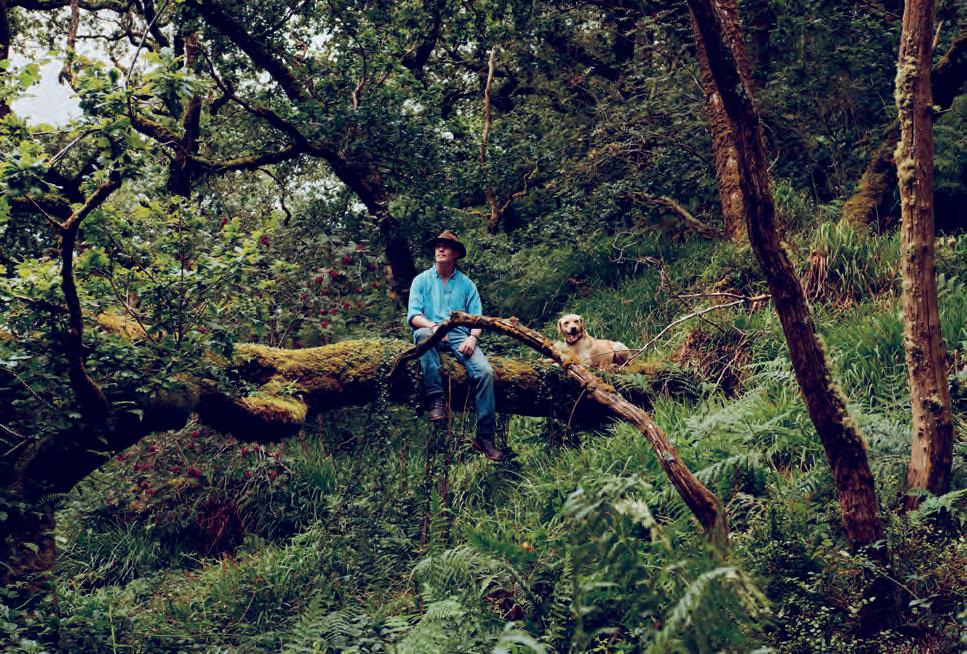

Merlin’s new book, Our Oaken Bones is a tale of reviving a family, a farm and an ancient rainforest. It is published by Penguin Books. In 2023 Merlin established The Thousand Year Trust as the only charity in the UK dedicated to the restoration of our temperate rainforest landscapes. The charity’s mission is to triple the amount of rainforest cover in Britain over the next 30 years. @thousandyeartrust

I try never to compare tropical and temperate rainforests. It’s a false comparison. The Amazon stretches for thousands of miles while our British rainforests are lucky to survive in hundred-acre pockets. One characteristic of our rainforests, however, which does deserve recognition is their dynamism. Tropical forests tend to be evergreen. They do not drop their leaves or experience large shifts in temperature or weather. Temperate rainforests have 52 different faces: one for every week of the year. In December, snow lies on the ground; in April, bluebells cast a purple glow across the valley; in July, the bracken is eight feet high.
One of my favourite times to wander through our rainforest at Cabilla is in October. The lush celadon green has transitioned to shades of copper, bronze, rust and terracotta. There is a sense of expectancy in the air as the trees, communicating via their mycelial wood-wide-web, chatter about who will be the first to discard their summer finery. The beech trees cast off their leaves first, followed by rowan, hazel and willow. Finally, the majestic oaks begin a gentle dance as the autumnal breeze picks up. As they shake their arms, their auburn offerings cascade down with a rustle akin to a silk gown shrugged from shoulders at the end of the evening. The forest is bare and beautiful in its state of undress.
For a moment, it feels like the party is over and silence will reign over the valley until spring. Then, suddenly, the mushrooms burst forth and a cornucopia of earthballs, stinkhorn, turkey tail, jelly ears, and parasols crowd into every available purchase. Identifying the diverse and magical world of our fungal cousins makes a visit to Britain’s autumnal woodlands a joy. Those who view our countryside as a place to explore only in the summer miss out on this dynamism, intrigue and beauty. I would encourage all and any to fill up a thermos, don a coat that feels like a warm cuddle, and embark on a mushroom hunt in our island’s wilder places. Just remember to never ‘munch on a hunch’ and that it’s far better to look and learn than to touch and damage.



The greatest reward for creating a beautiful home is more emotional than financial, says Giles Kime, interiors editor of Country Life.
Bringing a tired seventeenth-century cottage in Hampshire to life over the past few years has focused my mind on how one values a home. Is it really just another asset to be traded like any other? Or does its true value lie in the way it will enhance the time we’ll spend there?
In the last century, home ownership was high on the political agenda, from David Lloyd George’s ‘homes fit for heroes’ slogan –which enshrined his commitment to providing quality housing for soldiers returning from World War I – to Margaret Thatcher’s promotion of a property-owning democracy that stoked the housing boom of the 1980s. By the eve of the millennium, home ownership had risen from less than 20% to over 70%, precipitating an unhealthy fixation of the type that Lord Darlington describes in Oscar Wilde’s play, Lady Windermere’s Fan, as knowing ‘the price of everything and the value of nothing’.
Too often, the value of a property is seen purely in financial terms rather than its capacity to enhance our quality of life. As a result, much of our focus is on making changes that will appeal to future owners rather than ourselves. Yet, as Winston Churchill, that most quotable of British prime ministers, stated when he argued for the Blitz-damaged House of Commons to be rebuilt exactly as it was, ‘We shape our buildings, and afterwards our buildings shape us.’ In other words, when we plan a house, we need to put ourselves first.
Buildings that shape us in a positive way don’t have to be huge: too often, homeowners
look to expand their homes before they consider how existing spaces will be used –and whether a successful outcome lies in carefully considered evolution rather than expensive revolution.
It’s also rare that the dazzling bells and whistles of state-of-the-art appliances shape us – instead, it’s the comforting details of fitted and freestanding joinery, the beauty of good quality timber and textiles and well-engineered furniture, as well as colours and collections that make us feel at home.
These are the investments in a house that offer the most significant return, not just because they enhance quality of life but because they have a capacity for longevity, often improving as they age. You don’t have to look far for evidence of the long-term benefits of beautifully crafted, carefully considered interiors: the wealth of historic houses in Britain bears testament to the value they deliver not just over a lifetime but also as they pass from generation to generation. Discarding furniture that is just a few years old rarely offers much feel-good factor.
The other quality these houses share is timelessness; good design never dates, whether Georgian, Victorian, modernist or twentyfirst century. A capacity to age has less to do with making a visual statement and more to do with quality, physical comfort, and performance. As we complete the work on our cottage, we are very much hoping that our investment of time, money and thought will be repaid in dividends that are much more than merely financial.
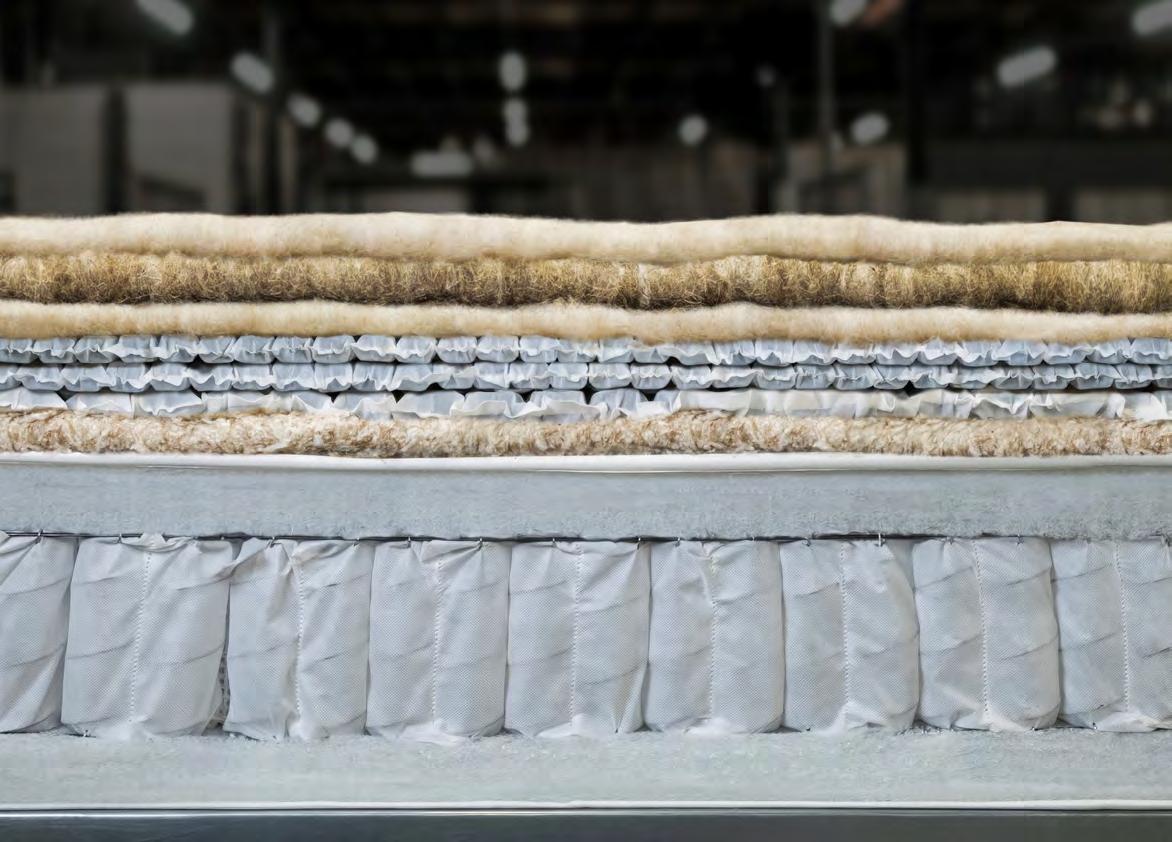
In the heart of Yorkshire, the soft bleating of sheep in the fields marks the arrival of a new day. The Harrison Spinks farm is home to a large flock of sheep who provide the wool for the hand-crafted mattresses at this heritage British company.

Sleep is fundamental to helping us feel better, and good quality sleep is even more important. At Neptune, our decades of expertise in crafting quality furniture, such as solid oak bed frames, meant that when it came to making our mattresses, we knew we could only work with the best in the craft.
Partnering with Harrison Spinks, whose mattresses prove how true luxury can be both responsible and supremely comfortable, was an easy decision for us. ‘They are a fifth-generation Yorkshire business that believes in doing things the right way, a sentiment that is very important to us at Neptune,’ says Sophie Miller, Neptune product developer.
Harrison Spinks have been making beds since 1840. Their factory sits in West Yorkshire, with the 300-acre farm just 18 miles away. It is where, as well as tending to the sheep, they grow the natural hemp fibres and linen flax used in the mattresses. The use of home-grown, natural materials is what sets the company apart and was a key reason for us working together on our new Dewsbury mattress collection.


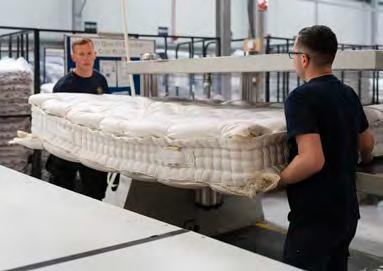


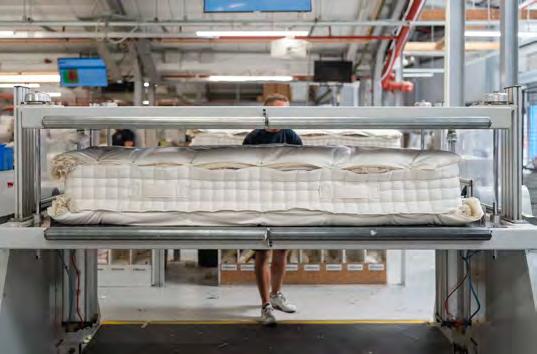
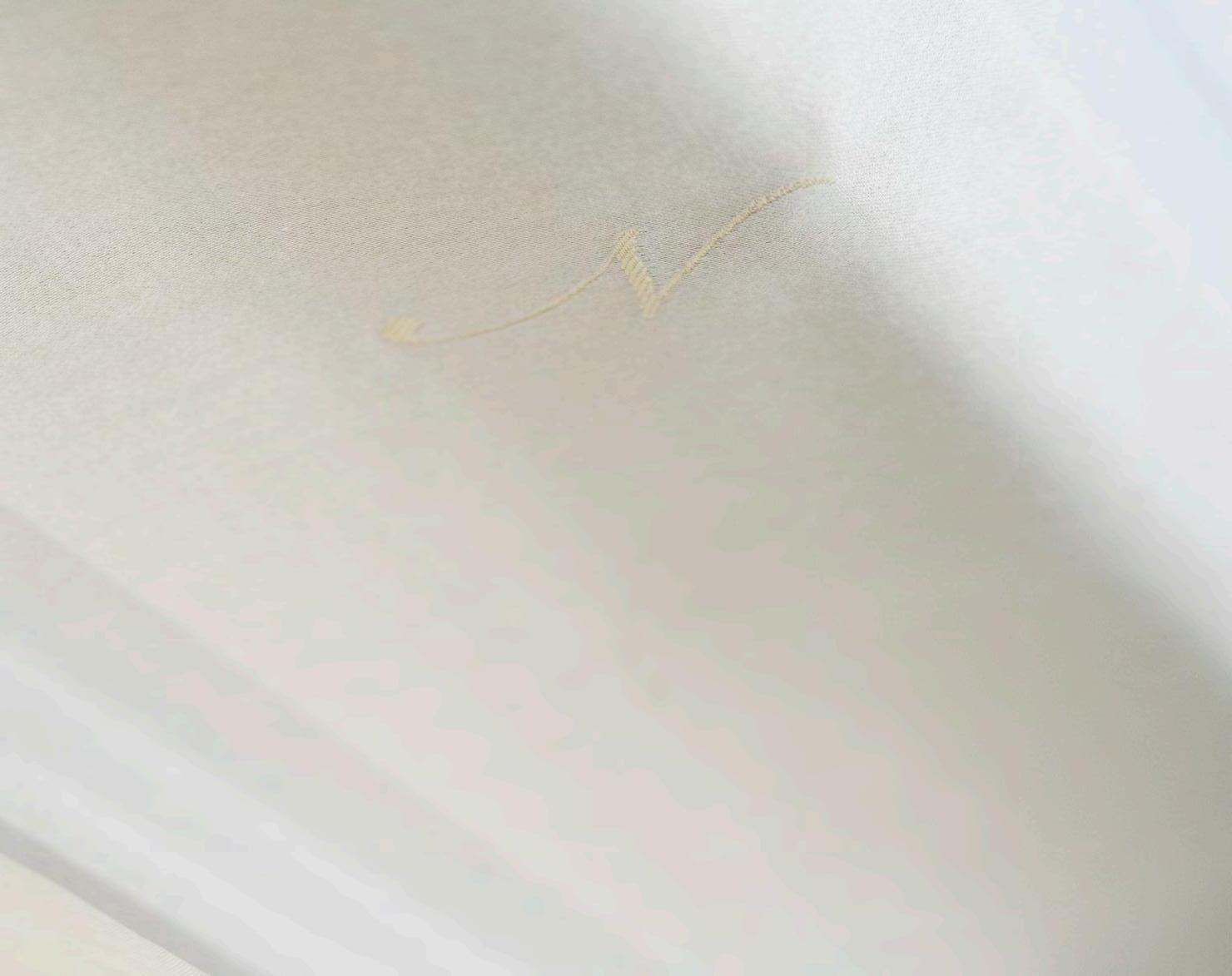
We spend a third of our life in bed, and it’s in this knowledge that Harrison Spinks prioritises materiality and sustainability with every design. ‘In addition to using wool from our farm, we are the first bedmaker to partner with British Wool to use 100% traceable British wool, so we know exactly where it’s sourced,’ explains Rebecca Mayes, our account manager at Harrison Spinks. ‘We also use our own home-grown hemp, as well as sourcing from a co-op of other local farmers. Every mattress is built on the belief in doing things the right way. And for us, that means caring about where everything comes from. It’s why we grow natural comfort fillings on our farm, weave our fabrics in-house, and make our own award-winning springs.’
Over 20 pairs of hands are involved in the making of just one mattress, including hand sidestitching, tufting, and edge-taping. Ensuring that craft and traditional making techniques are honoured, Rebecca explains how the home-grown fillings are delivered to the nearby factory, scoured and cleaned, before becoming the unique filling pads. ‘They are then generously layered with our own-design springs to provide the ultimate in comfort and support.’
And it’s this attention to craftsmanship that aligns Neptune and Harrison Spinks so well. Rebecca explains, ‘By handcrafting our mattresses, using home-grown natural fillings and inhouse manufactured springs, we can ensure everything is done with integrity and built for longevity.’ That’s the answer to sleeping well.
For our full mattress collection, visit neptune.com/mattresses

BROWN ON
As we launch our new paint shade, Saddle, author and colour expert Kassia St Clair roams free on the chameleon qualities of shades of brown.
‘A good painting, like a good fiddle, should be brown.’ Thus opined Sir George Beaumont, a nineteenth-century amateur artist, bastion of conservative taste, and key figure in the creation of the National Gallery.
Culturally speaking, shades of brown are chameleons, making them rather difficult to pin down. For Beaumont, for example, brown was about good judgement. It represented something solid rather than showy, a depth acquired with age, an appeal to hand-crafted traditions. Several decades later, during the 1890s, deep browns were linked with refinement and luxury – an association that lives on in the livery of UPS, which was founded around this time. When this colour was once more the talk of the town during the 1970s, its meaning had shifted again. Those who decorated in shades of tortoiseshell, burnt orange and mustard were signalling their connection with nature, a certain kind of spirituality, even respect for the earth itself.
Style, of course, is cyclical. So it’s hardly surprising that, after a lean few years when people were content to merely dip their toes into tan, fawn, beige, camel, and – at a push – café au lait, richer, deeper hues are once again in the ascendant. Now, however, how we feel about deep browns has further evolved. For one thing, those resonances that attracted previous generations – brown’s solidity, connection to the earth, and artisanal savour –have an added depth and meaning when transferred to a digital age. For another, it’s clear that this time our relationship with browns will be a deeply sensual affair. It’s no accident, for example, that so many popular shades are named for life’s luxuries: walnut, chocolate, mocha, coffee, cinnamon, mahogany. Shades that call to our senses.
The new Saddle brown is beautiful to look at: deep and rich, without being tawny, with enough softness to give it an air of calm. But it also has an added sensory pull, recalling the sweet, musky aroma of leather. For some, this might mean stables, with their fug of hay and horses; for others, it might conjure the warm nuzzle of a beloved leather jacket; or that particular smell you get when walking into a shop selling shoes and bags. It’s a colour that quietly seduces. That evokes heritage without being stuffy. And, of course, one that calls to the senses. We can safely say that Sir George Beaumont would have loved it.

TV presenter and author Michelle Ogundehin explains how to balance stronger, dark colours in a room scheme to maximum effect.
There’s been much talk recently in interiors of the 60:30:10 rule, a way of apportioning neutrals, darker shades and pops of contrast for the ‘perfect’ scheme. The theory is that, by following the given ratio, you maintain balance –your dominant colour calms, your secondary colour enriches, and your accent colour energises.
Ordinarily, I scoff at dictates. I believe they are a lesson in the dissolution of interiors to mathematical formulae, when place-making should be intuitive, loose and dynamic. What works in one space will not work in another. And rules are made to be broken.
However, when it comes to using dark tones in combination with neutrals, this ‘rule’ definitely has its place.
To explain. Drench a room entirely in colours like walnut, mustard, olive or chocolate brown, and it can add immense depth, warmth and refinement to a home. The feel will be sheer cocooning indulgence. If this is the goal, then do not veer from the path of the total envelopment, and do not feel compelled to add in any contrast. And the smaller the room, the better.
But, once you start to mix such shades with paler hues, it gets a little more complicated. The aim is for one to lift the other, bringing out the best aspects of all. As such, dark colours are best used to anchor key elements in a room. For example, Olive cabinetry in a kitchen
paired with Driftwood walls and an Orkney White ceiling would create a calm, grounded foundation.
In bedrooms, a dark feature wall behind the bed can feel both cocooning and restorative, especially when paired with lighter, calming contrasts such as Orkney White-inspired linen shades or a Silver Birch-painted ceiling. Accents of Blakeney Blue – perhaps in a velvet cushion or statement throw – could then introduce a bold, but balanced, elegance to this otherwise earthy palette.
Even Mustard, typically a more adventurous choice, works harmoniously when framed by deeper colours and softened by surrounding neutrals. Indeed, the key is to let such shades lead no more than about 30% of the space, thus grounding a room without overwhelming it. Then, your paler tones act as freshening agents, sharpening the deeper notes without feeling stark.
Nonetheless, consider the placement of dark tones carefully. Use them lower down – think skirting boards, cabinetry, or the bottom half of walls – balanced by lighter shades above. Finally, fulsomely embrace texture, and introduce layered lighting to bring darker surfaces to life, otherwise they could feel flat.
Result? A palette which combines calm, contrast and character, making any space feel instantly more considered.
Decorating with Neptune’s deeper shades
If you’re tempted to decorate with darker shades, colour-drenching Neptune colours like Ink, Constable Green or Walnut across woodwork, walls and ceilings is a beautifully enveloping solution. Eliminating the distraction of high-contrast lines, this technique blurs the edges of a room, creating a greater sense of space. It’s especially effective in smaller rooms such as snugs and cloakrooms, where our highly pigmented paint feels rich and velvety, even in low light.
As a mid-dark shade, our new mellow brown, Saddle, is perfect for bringing drama to stand-out pieces of furniture, like a dresser or kitchen island, without overpowering the room. Its grounded, earthy undertones ensure it pairs well with a broad palette of accent colours, too. Try it alongside warm greens like Olive, add contrast with the soft blush of Potter’s Pink or Old Rose, or for something a little unexpected, touches of Blakeney Blue can add a fresh lift while still feeling rooted.


In the first of our series on what home means to individuals, polar explorer and former army captain Preet Chandi MBE – who completed the longest solo, unsupported, one-way polar ski journey in 2023 – reflects on how memories of home comfort and bolster her when she’s alone on an expedition.
WHENI’m on the ice, alone in Antarctica, staring out at the nothingness of the big white desert, I dream about home.
Home isn’t just one place for me. It’s sitting on my mum’s sofa, legs stretched out, my kambal (blanket) covering me, and a cup of hot chocolate in hand. It’s being at my grandma’s house, surrounded by family, eating plain paratha, the kind only she can make. It’s going to my brother’s house and feeling at ease just being there. These memories are a far cry from the howling wind and biting cold outside my tent. Home isn’t just a location. It’s a feeling. It’s where my guard drops, where I don’t have to be strong all the time. It’s where I can speak in a mix of Punjabi and English that makes perfect sense to those who know me best.
When I think of home, I think of smells: haldi, garam masala and jeera sizzling in hot oil, fresh roti puffing up on the stove. I picture the photos on the walls that haven’t changed in years. It’s not perfect, but it’s ours.
I never imagined I’d end up here, alone in Antarctica. Growing up, I never saw people like me in these kinds of spaces. I didn't know what an explorer was. I joined the Army at 19, not knowing exactly what lay ahead, only that I wanted more. It was there that I first slept in a tent, trekked, and started building the skills that would eventually take me to the South Pole.
It wasn’t easy to take unpaid leave from work for my expeditions: the systems aren’t always built for people who step outside the norm. But something in me refused to give up. Those years taught me how to endure, how to lead, and how to listen to that quiet voice inside that said keep going. They were a bridge between the comfort of home and the wild unknown I now choose to walk into.
On expeditions, I carry small reminders with me: audio recordings from my family, the threads of rakhi tied around my wrist by my brothers. These simple things ground me. In the most extreme places on Earth, they remind me who I am and where I come from.
But home is also something I’ve learned to carry inside me. It lives in the resilience passed down from generations before me and in the stubborn determination of my younger self. It’s in the stories I repeat to myself when I’m pushing through -40°C winds; in the prayers I whisper when fear creeps in.
Home is love, history, safety, and identity all rolled into one. It’s where I first learned to believe in myself. And it’s what I return to – if not in body, then always in spirit.
Preet’s next challenge is to be the first solo female to reach the North Pole. Follow her plans and fundraising at polarpreet.com
So, when I’m thousands of miles away, skis crunching across ice, I hold on to that image: legs up, blanket on, chai in hand. And I keep going, knowing that no matter where I am, home is never too far away. Opposite: Preet training in Greenland

Ellie’s family kitchen exudes an enticing mix of Parisian grandeur and English country warmth.
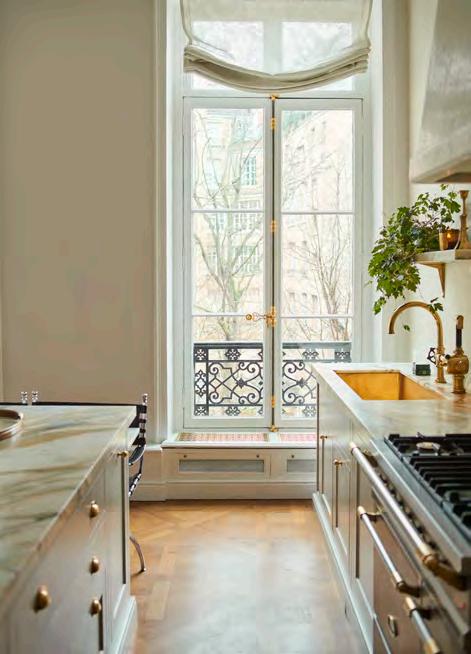

In the heart of Paris’s prestigious 8th arrondissement, where the Champs-Élysées cuts a course direct to the Arc de Triomphe, sits the apartment of a busy family of four (and Laika the dog). Built in the early Haussmann period, the property’s original layout comprised large, formal entertaining spaces and an impractically small kitchen tucked at the back of the apartment by the service stairs. When interior designer Ellie Peugeot and her family moved in, the space needed reconfiguring, as she explains: ‘Given the fact that we love to cook and have a young family, we wanted to create a large, open kitchen that was the heart of our home. We therefore sacrificed the second salon – called the petit salon – into a new open-plan kitchen which is right off the entrance foyer.’

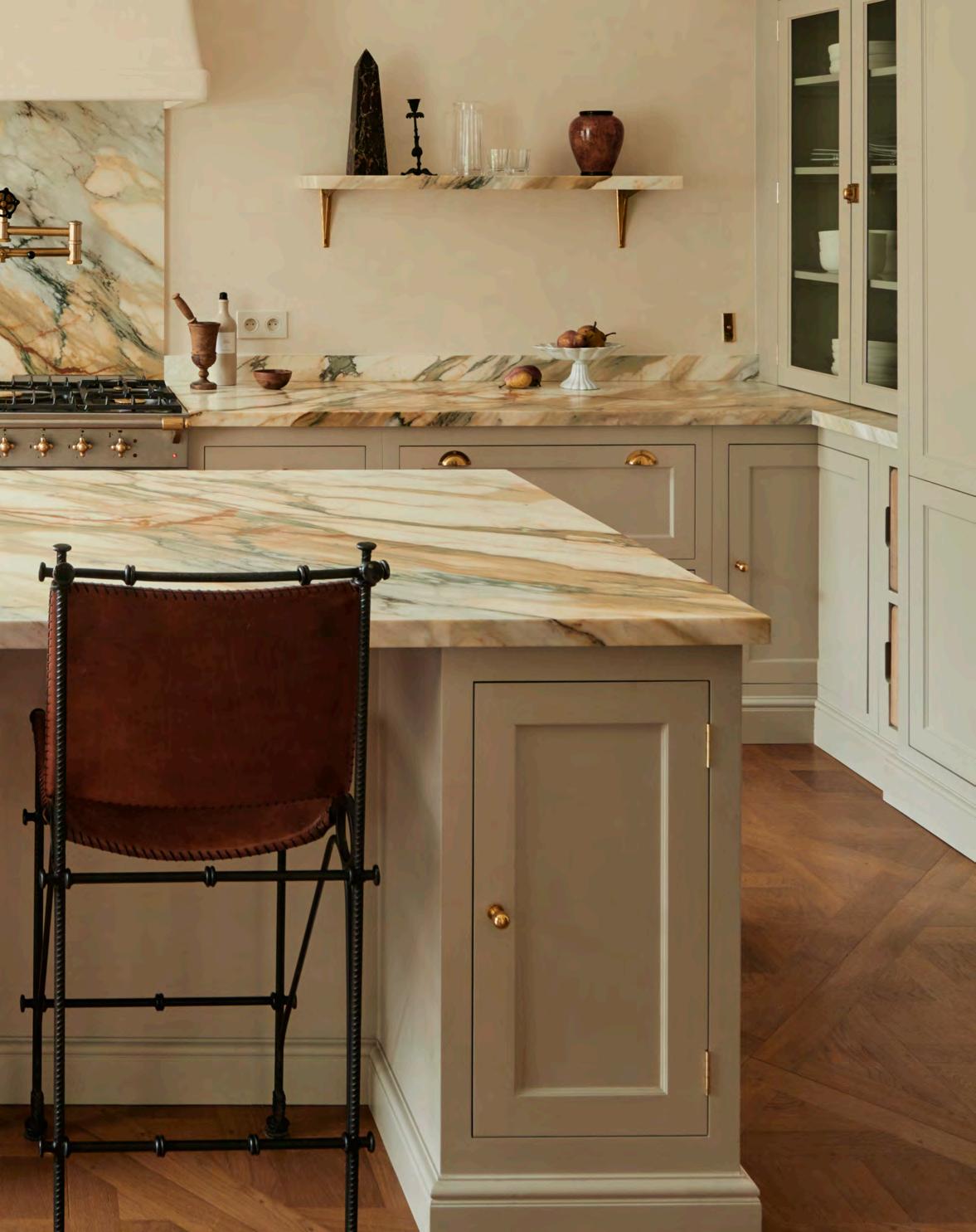

It was at this point that Ellie, who has designed many London projects, turned to Neptune. While the property is a testament to French architecture, with ornate plasterwork and intricate handmade panelling, she wanted to create a distinctly English kitchen that would sit comfortably alongside her elegant contemporary style.
Neptune kitchen designer Rémi Fiacchetti recalls the brief: ‘Ellie already had a layout in mind – an L-shaped kitchen with an island and a breakfast nook – and she wanted to keep her metre-long Lacanche range cooker. I advised against including the breakfast nook, as it has a more rustic look and didn’t feel quite right for a Parisian apartment. Instead, I suggested placing seating at the island and incorporating a standalone breakfast cabinet to create a refined, visually uncluttered layout.’
Ellie and her husband opted for Henley cabinetry with a large Suffolk larder customised with Henley-style mouldings. ‘I was drawn to the beautiful exposed wood on the Henley cabinet interiors and Neptune’s ability to make bespoke pieces to fit our needs,’ says Ellie. ‘I also loved the smaller details, like the pull-out rail for tea towels, the utilitarian metal storage inserts for cleaning products under the sink, the built-in chopping blocks, and the magnetic spotlights in the glass cabinets.’
Good flow, plenty of storage, and a lower-level counter on the main island where the children could have their meals were also high on the wish list. ‘We entertain a lot,’ adds Ellie, ‘so the kitchen needed two fridges, two freezers, two large bins, and two larders. We love that we have space for everything, whether we are baking with the kids or having a dinner party for 30 people.’
Once the layout had been agreed, Ellie looked to natural materials and the couple’s collection of artworks for aesthetic inspiration. ‘I had already identified a series of slabs of Calacatta Crestola marble in Italy that I knew I wanted to use, so this set the tone for the kitchen’s colour palette,’ she explains. ‘We also decided to make a bespoke Marmorino plaster colour for the cooker hood and walls to complement the warmer shades in the marble.’
A metre-long brass sink, 1970s Spanish leather bar stools, and campaign-style curule chairs add textured patinas and rich colour to the restrained space, while the parquet floor seamlessly links the kitchen with the formal salon next door.

The result? A hardworking family kitchen that exudes a unique blend of Parisian chic and English country warmth. It has also proved the most popular of gathering spaces in this stylish apartment, as Ellie notes: ‘It’s the first room you come into in the apartment, the place where we have breakfast together as a family every morning and the most packed spot whenever we entertain.’

Use our kitchen cost calculator to get an estimate of your Neptune kitchen’s cost, from cabinetry to installation. Then book a free consultation with our design experts and let the creativity begin. neptune.com/kitchen-estimator


It’s imbued with la dolce vita today, but espresso started out as a workaday drink, designed to keep people going. That’s a perspective I have a lot of sympathy with, having had a third baby a couple of months ago. Indeed, I’m writing to you from the realm of peasant-class, practical caffeination. But I digress. By the late nineteenth century in Europe, the delights of coffee were well established. Unfortunately, the brewing time – around five minutes a cup – required some hanging around, and not everybody could afford to wait. Working people, in particular, appreciated the pick-me-up, but didn’t have the freedom to navel gaze in coffee houses.
At the Turin General Exhibition in 1884, the inventor Angelo Moriondo attempted to address this gap in the market: he presented the first espresso coffee machine, a device that used both water and steam to batch-brew coffee quickly. By all accounts, the taste was pretty unwholesome: the coffee burned in the steam, and it was only available in bulk quantities. The organisers of the exhibition awarded Moriondo a bathetic bronze medal. But the forerunner to modern espresso machines was operational, and from then on, other inventors were off to the races.
water and steam was heated over an open flame. The results were, to be polite, inconsistent. Bezzera shrugged and sold his patents to Desiderio Pavoni, and after some tinkering, the two men debuted an espresso machine at the Milan World Fair in 1906 that looked remarkably close to many modern versions.
Crucially, though they were beautiful to look at, the atmospheric pressures that these early machines were able to achieve were less powerful than the units we use today, so as well as being overheated, the espresso lacked the carefully extracted, delicious “crema” that scuds along the top of a good shot. In other words, the coffee still tasted murky and burnt. But taste turned out to be beside the point. Espresso gained in popularity anyway, all throughout Italy. I am not surprised. Who cared if it was battery acid? It was a bone rattler, and it did the trick.

A short while later in Milan, in 1901, Luigi Bezzera –possibly inspired by Moriondo’s design or, god knows, maybe he’d just had twins – patented a machine that could produce a single shot of espresso. Now you could make an individual serving of astringent coffee rather than a family-sized vat. But the metal tank that held the
It wasn’t until the first steam-free horizontal machines, developed by yet another Italian, Achille Gaggia, went into production in the late 1940s, that the game changed again. The ability to exert pressure on the ground beans went up, the temperature of the water came down, and the softer, sweeter notes of the coffee were drawn out. The professional appliances that we see in coffee shops today are descendants of these mid-century, steam-free machines. Espresso evolved from a pragmatic punch of caffeine for workers into a pleasure, enjoyed for its own sake. Maybe that’s how I used to feel about it too. I can’t remember. Another cup, please.
This is the
TABLE
Inspired by the iconic twentieth-century chimneys of London’s Battersea Power Station, the new, solid oak Battersea dining table is testament to the exacting design and crafting principles that Neptune stands for. Available in both circular and rectangular configurations, the table uses traditional mortise and tenon joinery techniques, with turned legs, pillar details, and elegantly sculpted feet. With a nod to practicality and convivial entertaining, the inset legs mean you can comfortably tuck in extra chairs at each end. The more the merrier.
Discover our full table collection, visit neptune.com/tables


–
How to style an ottoman, with Meaghan Hunter, Neptune art director and stylist.

Ottomans have an elusive pull for interior designers. They provide a solution to room flow, an opportunity for decoration, and an additional seat. Whether used as a practical extension of a sofa or placed centrally in a living room as the axis around which everything else revolves, the ottoman offers a chance for creativity.
Our timeless designs use traditional joinery techniques and are expertly upholstered to add texture and variety to living spaces. From the more traditional buttoned style of the Arthur stool to the versatile Ophelia, with its concealed drawers that turn into handy top trays, each design can be styled to suit any interior.
Historically used as a central piece of seating in public rooms during the Ottoman Empire, today the ottoman’s versatility lends itself to a more decorative piece of furniture. You might use yours as a platform to create a cohesive display of favourite books and trinkets, for serving up afternoon tea, and as a useful surface for playing board games.
Read on for Meaghan’s five key things to consider when it comes to your choice of display pieces.
If you have a square ottoman, visually divide the space into quarters; for a rectangular design, work in thirds. Don’t be afraid to leave empty space, especially if you’ve chosen a patterned upholstery fabric. With a more decorative fabric, leave at least one third clear to appreciate the pattern. For a larger, neutral ottoman, aim to cover three quarters of the surface with lifestyle books and one quarter with a moveable tray.
Decorate your ottoman in layers. There are three things I always include: a square tray in which you can group together an odd number of personal objects; lifestyle books (with their spines turned out to the room) piled at least three to four high; and a scented candle on top, alongside a pretty box of matches.
Always place your tallest pile of books at the furthest point from your feet and then, when positioning smaller items on top, work in a diagonal format. With a candle and matches on one pile and then, on the opposite, maybe a couple of shells or a pretty paperweight.
Use lifestyle books to seasonally dress your ottoman. Swap the top books over regularly to change the colour palette or theme (I love having gardening books on top in spring, and cosy cabin books in the autumn). They will also work as conversation starters with guests.
Avoid tall objects. Instead of a vase of flowers, for instance, opt for a smaller bud vase with a single stem or a little posy of flowers. I’d also avoid over-filling the ottoman and ensure your tray and piles of books are easily moveable so you can still put your feet up.
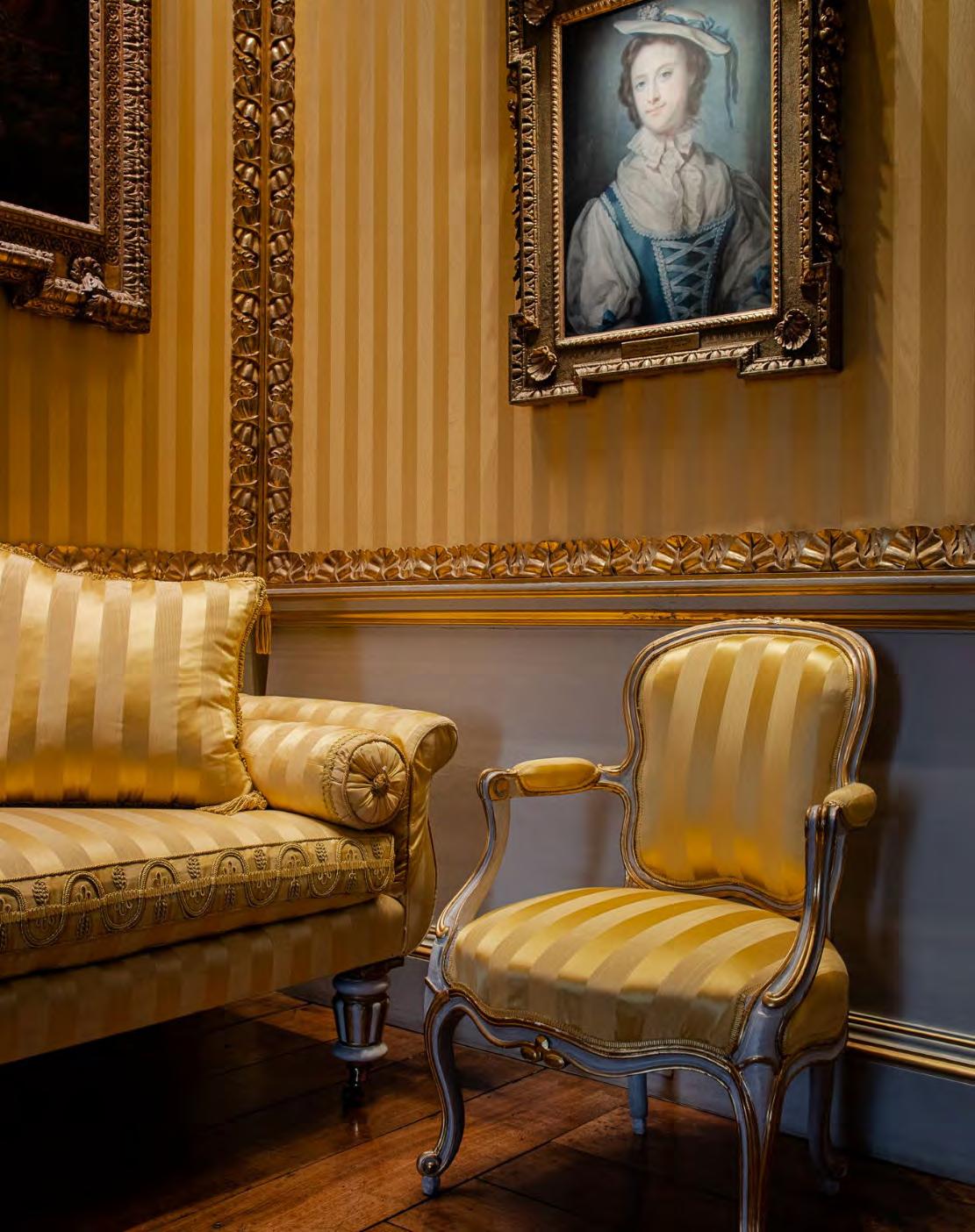
Sometimes, when restoring historic furniture, the upholstery is the only thing still holding the piece together, as art and design historian Ruth Guilding discovers when she visits Britain’s leading heritage restorer.
Alex Burnett has been working for upholsterers A T Cronin for 39 years now. It’s a business with an extraordinary archive of skill and talent, the foremost – and indeed, in some cases, the only upholster – that the National Trust, country house owners, and royalty entrust with their priceless furniture and restoration projects.
Ian Block oversees the heritage projects, while his daughter Sophie looks after contemporary designers, hotels, and highnet-worth clients. If you visit Britain’s grandest houses, their handiwork will be there – although there may be nothing to tell you so. The taboret striped silk of the walls, curtains and upholstery in Goodwood House’s Yellow Drawing Room is theirs. So are the rococo-style ‘stuck work’ and bed hangings on Thomas Chippendale’s superb four-poster at Dumfries House for The Great Steward of Scotland’s Dumfries House Trust (aka The King’s Foundation).
In 2022, they reupholstered the coronation thrones in crimson silk velvet for King Charles and Queen Camilla. While revenue from Castle Howard’s fictional role as Clyvedon Castle in the Netflix hit Bridgerton has helped to fund their work on the velvet seat furniture in Sir John Vanbrugh’s Tapestry Room (for this kind of work, all the materials are natural ones, applied by hand).
To understand the process, Sophie and Alex explain it to me step by step. For significant antique pieces, there is first a condition report, after which frames are stripped back and original nails, horsehair stuffing, and fabric are preserved. Joints are repaired with rabbit skin glue, webbing or tarp, seat bottoms replaced and stuffing reformed under a stitched-over cover of hessian or calico, after which another layer of stuffing may be added to correct sunken profiles on seats or elbows. Some old chairs had a well in the seat stuffed with horsehair, although Alex has found straw and even grass substituted.
Old silk, or silk velvet, ‘shatters’ or decomposes in sunlight, so existing upholstery may be repaired or replaced like for like (several different hand stitches may be used such as top stitch and blind stitch). ‘Sometimes you need to use staples, because someone’s put a tack where you need to put a tack and now the hole makes the frame too fragile for another,’ says Alex.
The process for a four-poster bed is just as methodical but involving far more draping and curtaining. ‘If you find woodworm or moths, they are usually dead, but upholstery may be the only thing holding furniture together,’ he adds. Alex has passed retirement age but craftsmen like him are scarce now, he says: almost no one is being trained up in the same painstaking, traditional way.
Hand stitching, tacks, nails, horsehair, and precise, moulded profiles are all antique upholstery hallmarks, having little in common with today’s seating options. Our modern sofas are far softer than those sat on by our ancestors, whose straw and horsehair mattresses were harder too.
In Cronin’s workshop, there’s a woodworking room where seat and bed frames are built from scratch, and a feather room where they fill all their own seat cushions. But ‘feather is sat in not sat on,’ says Alex, slightly disapprovingly, poised over his work on a gorgeous crimson velvet and gilt chair, with needle and thread in his hand.




At Neptune, many of our sofa and chair frames are inspired by heritage designs. They are made of solid tulipwood and plywood, and the seats are built up with foam, webbing and Serpentine springs. When it comes to cushion fillings, we offer an enhanced seating that delivers form and function. Some modern sofas have 100 per cent feather filled cushions but these require constant ‘fluffing up’. Working with upholstery experts, the team has landed on the ‘perfect balance’ of long-lasting fibre fill, wrapped up with the comfort and ‘sink-in-ability’ of feathers.
Our edited palette of five fabrics has been chosen for the way they perform on upholstered furniture and how they complement other materials in the collection. The cotton linen and pure linens are lightly textured, while our wool is luxuriously soft and durable, and the pile of our cotton-velvet is irresistibly luxurious. We also have a beautiful soft leather available on selected furniture. What’s more, we have tested the rub count of each fabric so our in-store design experts can help guide you on which fabric works best for different usage.





Starting with a simple, well-designed hammock and growing into a kitchen, furniture and homeware brand, this is the story of Neptune, so far…
Friends John Sims-Hilditch and Giles Redman set up a business designing and selling hammocks. In the first year, to their surprise, they sell over 5,500 hammocks. The following year, they launch the innovative rocking deck chair.

When John and his wife, Emma, struggle to find a good quality, reasonably priced bespoke kitchen, John decides to design his own. This leads to the early, freestanding elements of the Chichester kitchen – a dresser, bookcase, chopping block, kitchen island, and wine rack – followed in 2007 by the complete Chichester cabinet collection.
The entrepreneurial duo expands into garden furniture and travel to exhibitions to promote the collections, camping on the banks of the Rhine to save money at one furniture show. As the business grows, they move into a barn near Chippenham in Wiltshire.

The Chichester kitchen collection, where each cabinet is an individual element, capable of standing alone, proves such a success that the Shaker-inspired Suffolk and oak-and-painted Henley collections soon follow. John and Giles make a commitment to only use the best materials for their kitchens, never working with MDF or chipboard.




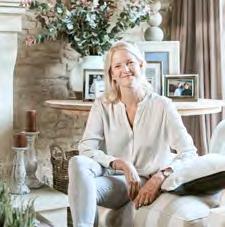
As creative founder, Emma uses accessories and extra furniture from the family home to style photoshoots. Customers regularly ask about these pieces, giving John and Giles the impetus to launch a homeware collection, starting with lighting and accessories.
A move into upholstery sees our first sofa, the Charlotte, launch, soon followed by two armchairs, the Sophie and the Amelia. More upholstered pieces come later, including beds and headboards along with a curated fabric palette.


Our first paint palette launches with Limestone, a warm stone shade, followed by Honed Slate and Lead Light – both still popular colours today.
This is a year of expansion. The first UK store opens in Winchester, followed by the first European store in Berlin. The team moves into a new HQ in Wiltshire featuring a showroom, café, offices, workshop, studio, and storage facilities.



In order to provide a seamless design and production service, we open our own state-of-the-art production house in Qingdao, northern China. In Wiltshire, the team embrace new digital platforms, launching the e-commerce website and the @neptunehomeofficial Instagram account.
This year the industry-leading Stories magazine launches. Featuring interior design advice, behind the scenes insights and recipes as well as new collection news, it sets a new benchmark for brand magazines.


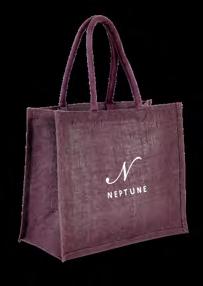
From 2015, the colour of our iconic jute shopping bags changes each season to reflect our latest paint shade. These bags quickly become collectors’ items, with 21 variations to date.

The retail design team renovate the old tram depot in historic Bath, creating a destination store with Neptune-designed and furnished apartments above.


The Provenist café opens in our Bath store with a focus on locally sourced produce and healthy, wholesome recipes.


A purpose-built barn in Knutsford – designed using locally sourced and reclaimed brick and tiles – is home to the latest store to open. There is even a resident peacock in the tranquil garden area.


Transforming a disused Grand Marnier factory, a second French store opens in the Parisian suburb of Neauphle-le-Château, while near Stuttgart in Germany, a traditional, half-timbered nineteenth-century building becomes Neptune Fellbach.

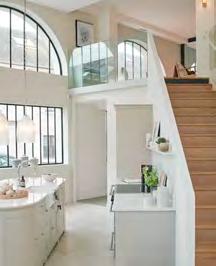

2023
Our Trade Membership programme for interior designers launches at leading design show Decorex and on the @neptunehomeofficial Instagram account. 2024
Honouring the heritage of John’s original kitchen vision and the brand’s DNA, a collection of cookware essentials and freestanding timber kitchen pieces launches, including a marble-topped island and oak butcher’s block which wins the Livingetc Award for Best Kitchen.


Our long history of designing garden furniture makes the RHS Chelsea Flower Show the perfect destination to showcase the collections. In both 2024 and 2025 the stands win five-star Trade Stand Awards.




Neptune design director Fred Horlock explains how to create a boot room (or entrance area) that combines form with function.
It’s a challenge for all of us: how to manage the churn of coats, hats, boots, pet paraphernalia and outdoor equipment that is constantly trailed in and out of the house. It’s why a boot room ranks top of many interior wish lists alongside walk-in pantries and all-singing laundry rooms.
Once known as the ‘tradesman’s entrance’, the area around a back door, side entrance, or – when square footage allows – the boot room, can be one of the most hardworking and potentially useful areas of the home. As Neptune’s design director, Fred Horlock, explains, ‘Giving as much space as you can to these areas reduces the clutter in the rest of your home.’
However, with such a focus on the utilitarian nature of this space, it is easy to overlook its design and aesthetics, all of which can help make it far more efficient and effective in the long run.
‘The main considerations for a boot room or entrance space are threefold,’ says Fred. ‘Firstly, storage and functionality: ask yourself what you need to fit in and how many people (and pets) will be using the space regularly. Secondly, consider your budget. It is an investment to install banks of fitted cabinetry but the storage they offer will pay dividends. Equally, there are plenty of budget-conscious solutions to make the space work hard too. And finally, the area is still an entrance into your home, so think about first impressions and how to make it feel welcoming.’

With storage being key to the efficiency of the space, Fred suggests building cupboards along one wall and balancing this with bench seating and low storage on the opposite side. If the area is visible from other rooms, then use concealed storage; if it’s not in view, you can opt for a mix of open and closed storage with rows of hooks for quick access to coats, open shelves for shoes that need to be aired, and breathable wicker baskets for scarves and gloves.
‘If space is tight, I’d go for freestanding pieces,’ he adds. ‘The Frome cabinet, the Henley storage box or even the Chichester housekeeper’s cupboard all offer generous storage.’ If you are carving a boot room area out of a nook or corner, Fred recommends translating the essential design elements of a fitted boot room – like tongue and groove walls, coat hooks, and a bench seat – into the compact space.
Lighting is an important element of a boot room. Natural light from windows or a glazed door is preferable as this is a dressing area, while spotlights positioned around the perimeter of the room will reduce shadows so you can see what you are doing on a dark winter’s morning. Wall lights will infuse the space with a softer atmosphere and can be left on to create a glowing, inviting light to return home to.
Finally, Fred suggests decorating the space to be robust and functional as well as attractive: ‘Tongue and groove panelling painted in an eggshell finish is a good choice as marks can be wiped away easily. I’d use a mid to dark tone and apply the paint as a colour drench over walls, woodwork and even the ceiling as it will balance out the busyness of this hardworking space.’
Fill the main, long wall with a combination of open and closed fitted storage, and break up the bank of cupboards with inset seating. On the opposite side, introduce a utility area for washing down muddy dogs and boots. Pull the space together with wrap-around tongue and groove panelling in a robust eggshell finish, and wash the same colour across all the walls, cabinetry and woodwork. Finally, add a unifying cornice around the room.

Avoid fitted cabinetry in a narrow room: seeing the room’s corners will give a sense of space. Use freestanding storage pieces like our Henley benches with hooks above, balanced with a console and mirror, and lay floor tiles horizontally – all of which will make the room feel wider. Soften corners with useful pieces like a stool or umbrella stand. If the room has a low ceiling, run tongue and groove panelling to full height; if it is high ceilinged, finish the panelling three-quarters of the way up the wall to give a lofty feel.

To create a boot room out of a small or awkward area like the space under the stairs, apply the same principles, materials and finishes of a larger boot room. Bring in similar aesthetic cues like tongue and groove panelling, coat hooks and a fitted bench with storage underneath. Avoid freestanding furniture as it will create shadowy corners which will make the space feel tight. Finally, keep the colours dark rather than light and bright: you’re aiming for a look that’s smart rather than attention-grabbing.
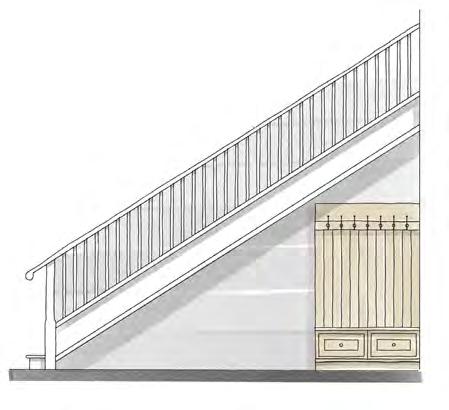

Stone floors are best for practicality. A sealed limestone floor will look smart, while a terracotta tiled floor will connect inside with the earthiness of outdoors. However, as this is an area that will get wet and dirty, avoid wooden flooring as it will scuff quickly and be harder to clean.
Because this is a transition area where people don’t linger, it is a good opportunity to use strong colour (a little like the approach to decorating a cloakroom). Use contrasting colours between adjoining rooms –such as a darker boot room leading to a lighter, paler
kitchen – to stop them merging into one and help ease the transition into the main home.
While boot rooms are functional spaces, they can still look decorative and welcoming, with stylish hardware and considered colour palettes. Add a mirror, console, table lamp, and artworks to soften the scheme.
If space (and budget) allows, a sink is a great addition –as is a dog shower, if required. It is incredibly useful to be able to clean outdoor equipment, from boots and garden pots to freshly dug-up veg, stopping the dirt flowing further into the house.
For our full collection, visit neptune.com/bootroom

As we launch our new boot jack, it feels like a good time to explore the heritage of an Irish brand making boots not only to stand proud in boot rooms, but to be truly lived in.
If you’d told the founders of a small Irish footwear co-operative in 1937 that their boots would one day be worn by Norwegian fishermen, British royals, and Glastonbury festival goers alike, they might have paused for a moment. But then again, Dubarry of Ireland always believed its boots would find a place on every foot.
The story begins in Ballinasloe, a quiet town nestled in County Galway. In the face of economic hardship, the local Chamber of Commerce sought to create employment by launching a footwear co-operative. The name they chose? Dubarry, borrowed from Madame du Barry, the famed French courtesan and mistress of King Louis XV. An unlikely muse for an Irish bootmaker, but that was precisely the point. ‘The founders sought to distinguish themselves,’ explains brand manager Charlotte Strange – and they did so with a touch of continental flair.
Dubarry has since outgrown its co-operative roots but still designs all its products in house in Ballinasloe. The boots have evolved, of course. First came classic country shoes. And then, in the 1970s, inspired by Galway’s rich maritime heritage, they turned to the seas. Charting a new course into high-performance sailing footwear, Dubarry launched the Shamrock – the world’s first waterproof, breathable sailing boot. A unique combination of luxurious leather with pioneering GORE-TEX® technology, the Shamrock remains a firm fixture at prestigious regattas worldwide.
Today, of course, it’s the iconic Galway boot that defines this heritage brand. Symbolising a return to their Irish country roots, the boots are ‘instantly recognisable by our shield logo and the two mid-panel straps,’ says Dubarry’s senior designer, Toinette Seymour. More than just a branding detail, the straps contribute to the Galway’s distinctive silhouette. They’ve become the uniform of dog walkers, equestrians, race goers, and city dwellers. ‘We love nothing more than seeing our boots being put to the test and becoming a staple item in our customers’ wardrobes,’ she adds. Harnessing the same GORE-TEX® technology pioneered in the Shamrock, the Galway is crafted for practical wear. Each pair is cut and closed by hand from 18 pieces of premium leather before being bonded to a high-performance sole designed to brave all weathers.
Yes, they come with a premium price tag, but like a finely crafted oak table, they’re built to wear in, not out. They improve with age, developing a unique character and patina that reflects a life well-lived. ‘With proper care, our boots can last a lifetime,’ Charlotte affirms.
LOOK UP
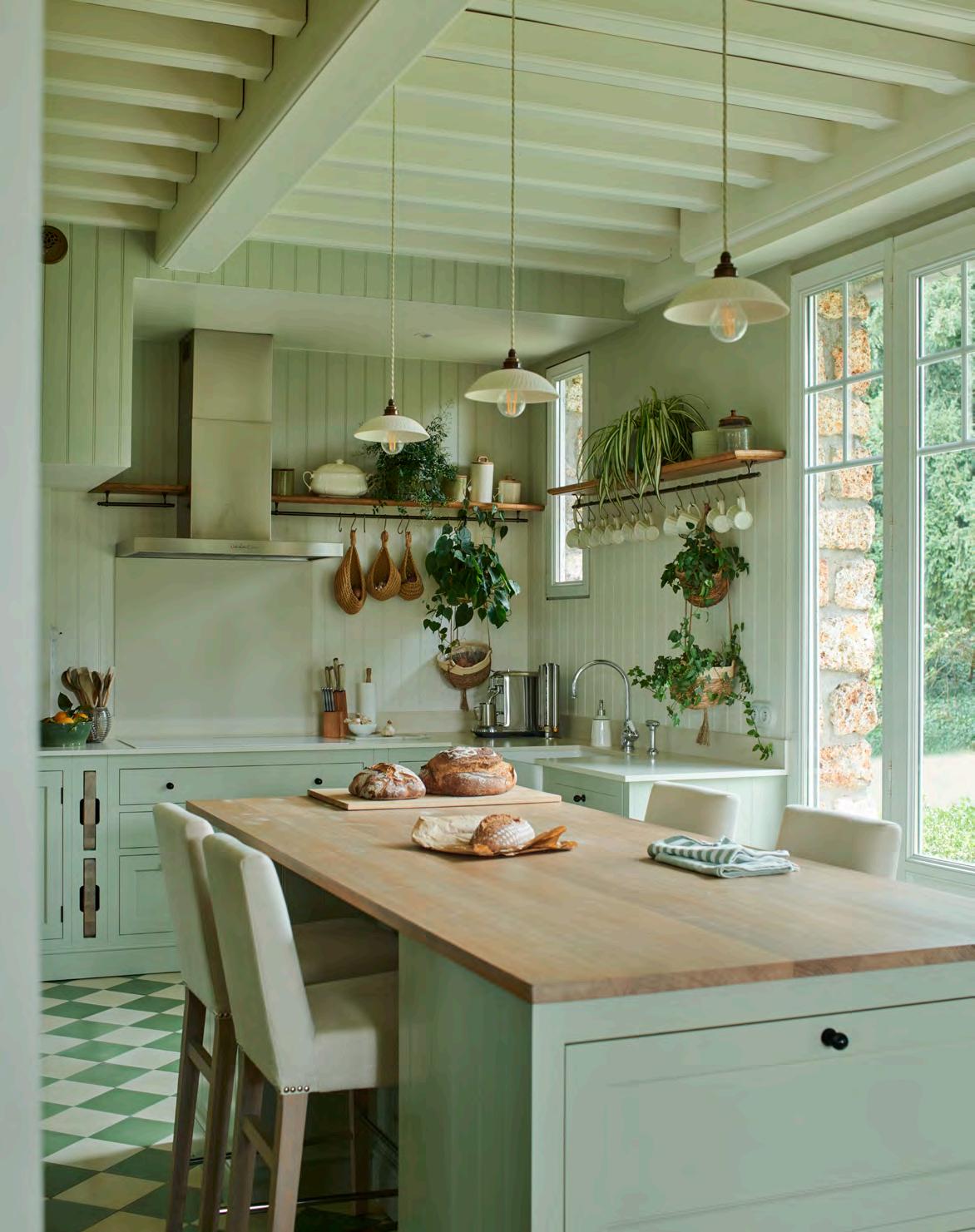
Whether left bare or painted, beams can play far more than a supporting role in a room, as Jessica Doyle, interiors editor of The Telegraph, discovers.
Form and function are not always easy bedfellows when it comes to interior design, but exposed beams within a room are a perfect example of marrying practicality with beauty. Essentially a structural element, beams, when exposed, add far more to a room than merely support: when treated with care, they bring texture and depth, and enhance a room’s aesthetic.
The interior designer Samantha Todhunter has identified a returning trend for exposed beams in the home, partly thanks to a move towards decorative lighting. ‘In the past, people wanted to tidy everything up. Everyone wanted recessed lighting, and features such as beams were covered,’ she says. ‘Now, however, I feel people are stripping ceilings back again and going much more for decorative lighting.’
rusticity, cosiness and warmth. Elsewhere, painting beams the same shade as the ceiling will lighten the effect: a technique that aligns with the look of a breezy beachside property or contemporary country house. In a home with low ceilings such as a traditional cottage, where a heavy wooden beam can appear a little oppressive, painting the beams to match the ceiling is a decorative device that will also give the illusion of more height.
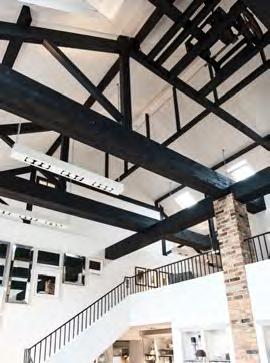
Samantha has worked on several rural projects where buildings such as barns and cowsheds have been converted into dwellings. ‘In those kinds of buildings, it’s crazy to consider covering up the beams because they’re beautiful: they’re part of the structure and they add this lovely layer of atmosphere and detail to the space,’ she says.
Her treatment of them will depend on the context of the building: in a barn, for example, exposing wooden beams and staining them or leaving them bare will add
When considering whether to expose the beams in a room, Samantha advises bearing in mind not only the expense of removing the ceiling, but also the effect it can have on energy efficiency. ‘Stripping out a ceiling will give you a layer of beauty, but heat will dissipate, so you have to put in counter measures to factor in this added volume to the space,’ she says. Equally, adding beams to a room will not always necessarily suit the location or style of the property: the ceiling in a townhouse might be better suited to a decorative cornice or panelling, for instance. Samantha has, in some cases, pared back the number of beams in a room where they were not needed for structural reasons and were overwhelming the space.
But in the correct context, and with the right treatment, beams can play far more than simply a supporting role, adding a layer of texture and character that makes the ceiling the star player.
We love using beams in our stores, whether they’re structurally part of the building or added for decorative effect. From our Cranbrook panelling paired with beams that give a traditional country feel to our York store, to a large, pitched ceiling in Cheltenham where trusses were added to complement the room, our use of beams is always sympathetic to the architecture and environment. Canterbury is one of our most intriguing stores. It was previously an old oast house, and our design team were keen to keep the existing exposed oak beams and original pulley mechanism (used for the hops grown in the fields opposite), paying homage to the building’s heritage and creating an inspiring store space at the same time.

As the weather cools, swap alfresco suppers for autumnal lunches under a terrace, in the greenhouse or simply keep the kitchen doors open and enjoy the crisp, refreshing air. Sarah Jane Bellmaine, lead chef at The Provenist, shares her three favourite autumnal recipes, all rooted in hearty, vegetable goodness.
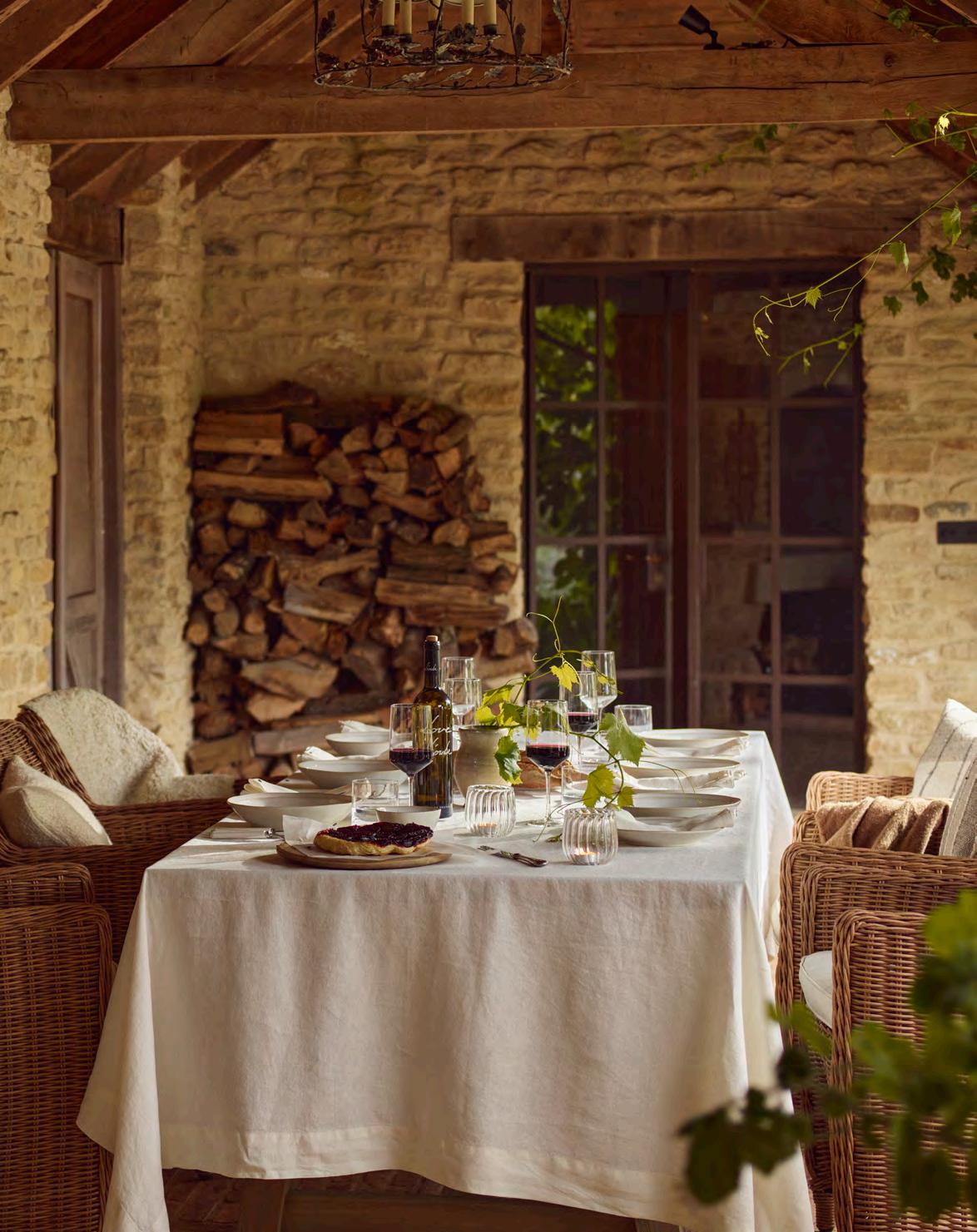
Makes enough for four
Add some colour to the table with this vibrant take on the classic French dish.
Beetroot is a great source of nitrates and is also packed with antioxidants, vitamins and minerals. Swap out the feta for goat’s cheese or scrambled tofu to add protein, if you prefer.
WHAT YOU’LL NEED
4 individual-sized tart tins
12 baby beetroots
2 tbsp balsamic vinegar
2 tbsp brown sugar
A pinch of sea salt and black pepper
1 box of ready-rolled puff pastry
Whipped feta, to serve (optional)
1 Roast the beetroots by wrapping them in foil and baking at 200°C for around 40 minutes, depending on the size.
2 In the meantime, heat the vinegar and sugar until slightly thickened. Spread the mixture between the four tart tins.
3 Once the beetroots are cooked, remove the skins and cut each in half before seasoning. Place them in the tins (cut side down). Cut rounds of the pastry approximately one centimetre larger than each tin, place on top of the beetroots, and tuck in the edges.
4 Bake the tarts at 180°C for around 30 minutes until the pastry is golden. Remove from the oven and flip the tins over carefully to release the tarts. Serve with a little whipped feta if you like.


Makes enough for six
This is a hearty, warming pot full of goodness. You can substitute the parsnips for swedes or celeriac and dial up the heat further with hot, smoked paprika or even a sprinkle of finely chopped, fresh red chilli pepper.
For the stew
500g sweet potatoes
2 carrots
2 parsnips (Alternatively, use any root vegetable you like e.g. swede, celeriac, fennel)
2 tbsp light olive oil
A pinch of sea salt and pepper
10g harissa seasoning
2 red onions, finely chopped
4 cloves garlic
2 tbsp smoked paprika
2 tbsp tomato purée
3 tbsp rose harissa paste
18g vegetable stock powder
1.2l water
100g kale
270g tin mixed beans
To make the stew
1 Peel and chop the vegetables, keeping them chunky. Place them in a roasting tray with the oil, salt, pepper, and harissa seasoning. Roast at 190°C for around 30 minutes.
2 W hile the vegetables are roasting, sauté the red onions and garlic until soft and slightly golden. Add the smoked paprika and tomato purée and allow to cook through again, then add the rose harissa paste. Finally, add the vegetable stock powder and water, and simmer for ten minutes.
3 Once the vegetables are roasted, add them to the broth. Drain and rinse the mixed beans and roughly chop the kale, then add to the stew and serve with the herb-infused quinoa.
To make the quinoa
For the quinoa
200g red quinoa
200g white quinoa
10g vegetable stock powder
800ml water
2 tbsp chopped parsley
1 sprig thyme
1 tbsp chopped rosemary
Sea salt and pepper, to taste
1 Wash the quinoa in a fine sieve, then place into a pan with the water and vegetable stock.
2 Simmer for around ten to 15 minutes until cooked and the liquid is absorbed.
3 Fluff up the quinoa and add the chopped herbs, salt and pepper. Cover and allow to infuse for five minutes.
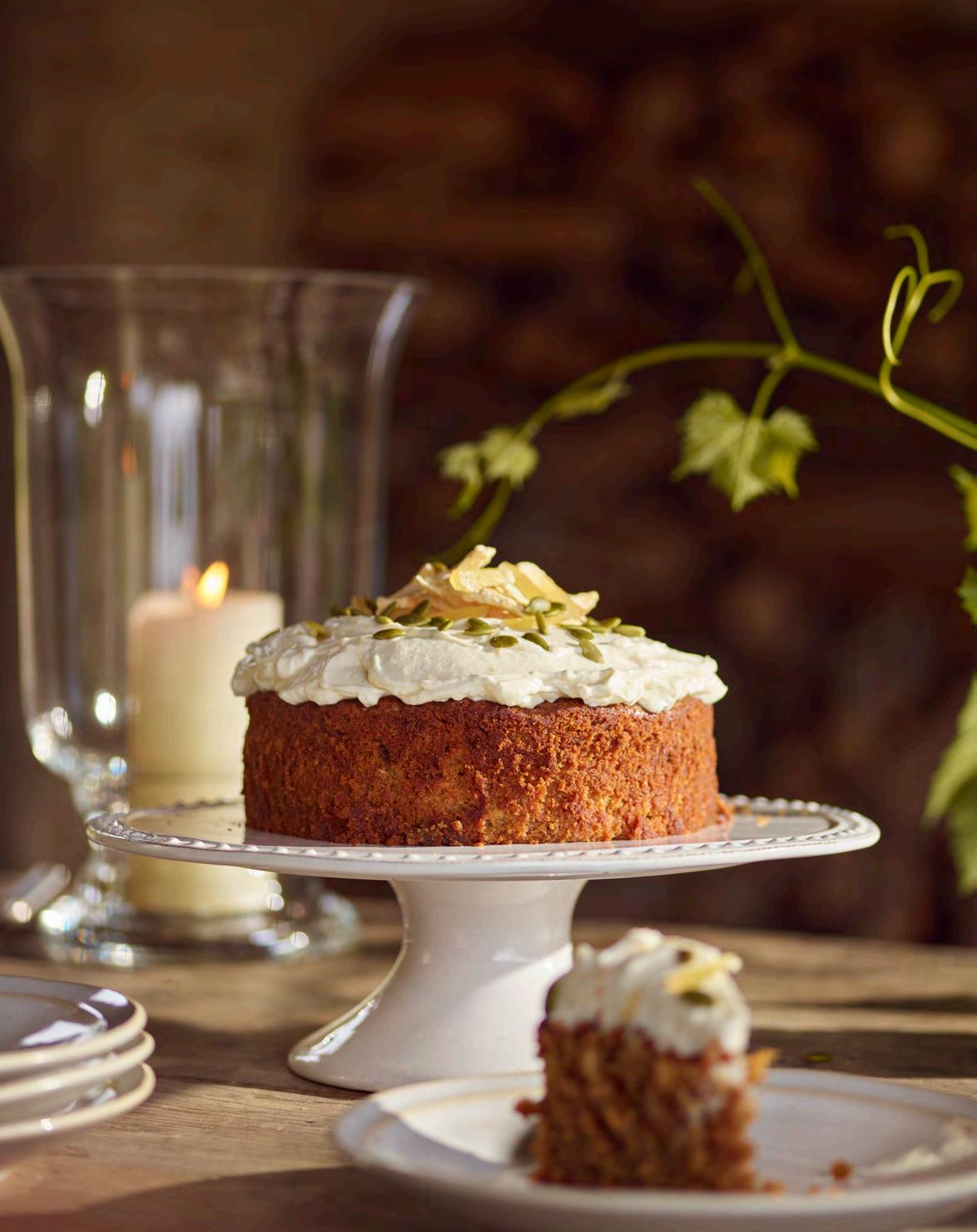
Makes enough for eight
Zingy, thanks to the ginger; tart, thanks to the Bramley apple; and wholesome, thanks to the parsnip, this cake is my favourite autumnal alternative to the classic carrot cake we all know and love.
WHAT YOU’LL NEED
For the cake
8-inch baking tin
245g parsnips, peeled
1 bramley apple
245g self-raising flour
245g soft dark brown sugar
3 large eggs
185g light olive oil
1 tsp ground ginger
1 tsp mixed spice
For the icing
350g cream cheese
2 balls stem ginger, grated
100g icing sugar
For the garnish
Dried apple
Stem ginger
Pumpkin seeds
1 Preheat the oven to 160°C, and line an eight-inch baking tin with parchment paper.
2 Grate the parsnip and apple. Mix all the ingredients in a bowl until well combined.
3 Pour the mixture into the tin and bake for around an hour, until golden brown. Set aside and allow to cool before icing.
4 To make the icing, mix the ingredients until smooth, then spread over the top of the cake. Garnish with dried apple, more grated stem ginger, and pumpkin seeds.
This is the
Discover our full coffee and side table collection, visit neptune.com/coffee-side-tables Lamp stand. Drinks surface. Vase, book, or trinket repository. The side table is a versatile and useful addition to any sitting room, whether symmetrically balanced on either side of a sofa or adjacent to an armchair, grounding it in a space. Our new solid oak Thornbury pedestal side table was inspired by the traditional and elegant silhouette of Edwardian designs. Slender and proportionate, with a recessed top, tapered legs and sculptural turned detail, Thornbury introduces a refined edge and useful surface wherever it stands.


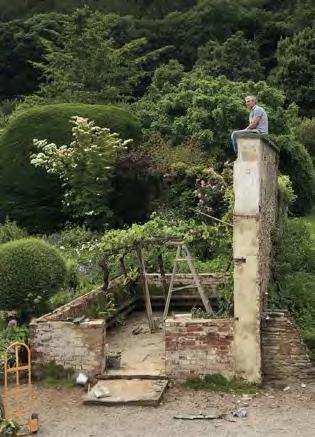
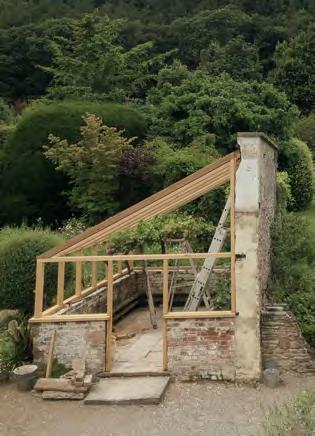
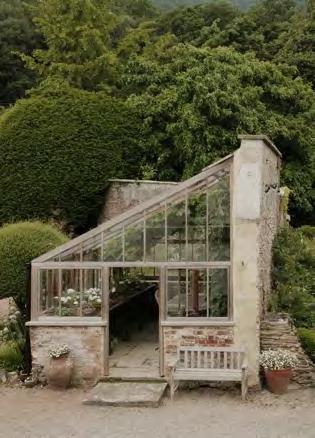
As a child, I grew up having afternoon tea in our family greenhouse, or, as we call it, the vinery. As an adult, I spent a long summer renovating that same vinery in order to keep alive the strong emotional attachment I have with it.
Having moved back, in 2012, into what had been my childhood home, my husband, Thomas, and I spent the first few years renovating the house before turning our attention to the garden, in the centre of which was the vinery. Nearly a hundred years old, it was somewhat decrepit, with the roof held up by a single, long pole. Not a place to walk in, let alone eat a meal in.
We had endless discussions about how best to renovate it, or indeed if it was even viable to do that. The cost of getting a greenhouse contractor to do it, we knew, would be prohibitive, and something about the impersonality of doing that didn’t appeal. Then we thought of Bernie, the wonderful local carpenter who was slowly working his way around the house repairing all the old sash windows. Would he be interested in taking on what seemed an insurmountable task? To our relief, he accepted the challenge and agreed to do the job – on condition that Thomas helped him.
Photographer Harriet Thistlethwayte recounts how she and her husband restored an old greenhouse in the Herefordshire garden of the home she grew up in.
On a cold spring day in 2019, Thomas demolished the wooden part of the old vinery, something I couldn’t bring myself to watch, leaving the age-old support wall standing alone. We propped the vines on a precarious system of ladders, not knowing if they would survive.
Bernie, having already meticulously measured every inch of the building, constructed the cedar frame in his workshop, and it was a truly happy day in June when he turned up with it and rebuilding could begin.
Throughout that summer, slowly, painstakingly the vinery came back together, a bit like a jigsaw, every batten of wood having to be a slightly different size to take into account the twisting back wall, each pane of glass measured individually. It was a labour of love and skill by two people invested in preserving a century-old building in the most sensitive way possible with craftsmanship, diligence and hard work. Finally, one misty autumn morning, it was finished.
The vines survive, twisting through the structure and producing bunches of sweet grapes every autumn. But the vinery has become so much more. We set up a large table in there and, during lockdown when two of our children, along with partners plus two grandchildren, came to live here with us, it was in the vinery that we ate supper every evening. New memories to cherish have been made, and now my grandchildren enjoy afternoon tea in our renovated greenhousevinery whenever they visit, just as I did.

NEW for 2026

The future of
Introducing the evolution of freestanding design.
Last year, we launched the first pieces of our Borough kitchen collection, and now we’re taking freestanding one step further. Using the principles of traditional joinery and craftsmanship, the next step is your kitchen appliances – think cooker, sink, fridge, and dishwasher – integrated into exceptional standalone cabinetry. Installed in a day, a new way of kitchen design is coming in the new year.


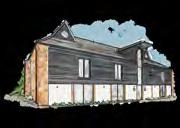













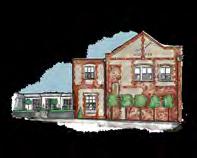



With over 30 stores across the UK and Europe, our friendly teams look forward to welcoming you to your local store, or why not venture further afield and explore stores in different locations? Each one has been individually designed as a relaxing home-from-home and is full of decorating ideas for your home.
To find your nearest store, go to neptune.com/our-stores



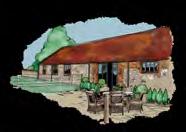








UK
Bath BA1 5BD
Belfast BT7 3GB
Bristol BS8 2QY
Bury St Edmunds IP33 3PH
Cambridge CB22 7PX
Canterbury CT1 3TY
Cheltenham GL50 4DW
Chesham HP5 1NG
Chester CH2 4JR
Chichester PO20 2EW
Chiswick W4 4HH
Colchester CO3 8LT
Edgbaston B15 3AA
Farnham GU9 0BB
Fulham SW6 2TD
Guildford GU1 3AJ
Hailsham BN27 1DQ
Hove BN3 4QD
Knutsford WA16 8TA, Reading RG10 9SA
Redbrick WF17 6JF
Southport PR4 6JA
Tonbridge TN9 1RF
Weybridge KT13 8DX
Wimbledon SW19 1RX
Winchester SO21 1HL
York YO32 9TW
Wiltshire Outlet SN5 8YG
We have Neptune stores across the UK, Ireland and Europe. To see all of our homes, visit neptune.com/our-stores
Store in store:
Neptune by Treehouse Midmar, Aberdeen, AB51 7NB
Neptune by Creative Classics, Ayr, KA7 2HD
Neptune by Sims Hilditch, Bath, SN14 8JR
Neptune by Woods of London, Blackheath, SE3 0TA
Neptune by Hunters, Derby, DE1 1SY
Neptune by Richard F Mackay, Edinburgh, EH11 2SG
Neptune by Malone and Smyth, Derrychoran
Neptune by Bridgewater Interiors, Gateshead, NE8 2AJ
Neptune by Aberford Interiors, Leeds, LS25 3DP
Neptune by The Georgian House Ludlow, SY8 1AT
Neptune by Kendrick Interiors
Market Harborough, LE167DS
Neptune by Appleyard, Norfolk, NR25 6AR
Neptune by Wilton Kitchens, Salisbury, SP2 0HX
Neptune by Holloways, Worcestershire, WR6 5DE
Neptune by Bradley Gardens, Wylam, NE41 8JH
Neptune by 1933, Co. Meath
Neptune by Browsers, Limerick
Neptune by Global Village, Dublin
Neptune by Global Village, Wicklow
Neptune by The Orchard, Co. Kildare
Neptune by Trevor Morrow, Co. Mayo
Neptune by Castle Cabinets, Kilkenny
Neptune Paris
Neptune Paris Ouest
Store in store:
Neptune by Beaumont Trélissac
Neptune by Fabrica, Eymet
Neptune by Just Kitchens, Miélan
GERMANY
Neptune Berlin
Neptune Fellbach
Neptune Tegernsee
Store in store:
Neptune by Helma Interior, Heidelberg
Neptune by Faszination Oschatz
AUSTRIA
Neptune by Steinwender, Wien
BELGIUM
Neptune by O&V Home Interiors, Seneffe
ITALY
Neptune by Adi Arredamenti, Brescia
Neptune by Forteshire, Forte dei Marmi
LIECHTENSTEIN
Neptune by Allure, Vaduz
SWITZERLAND
Neptune by Styles Interiors, Mont-sur-Rolle
Neptune by Friolet Interiors, Zurich
Neptune by The Classic House, Weteringbrug (near Schiphol)
We do everything we can to make sure Stories is as environmentally sound as possible. The paper we use comes from responsible sources, and is also carbon balanced by the Woodland Trust.
Please note that, while the colours shown in this volume are as accurate as possible, they will not always precisely match our paint shades. All information and pricing is correct at time of printing.
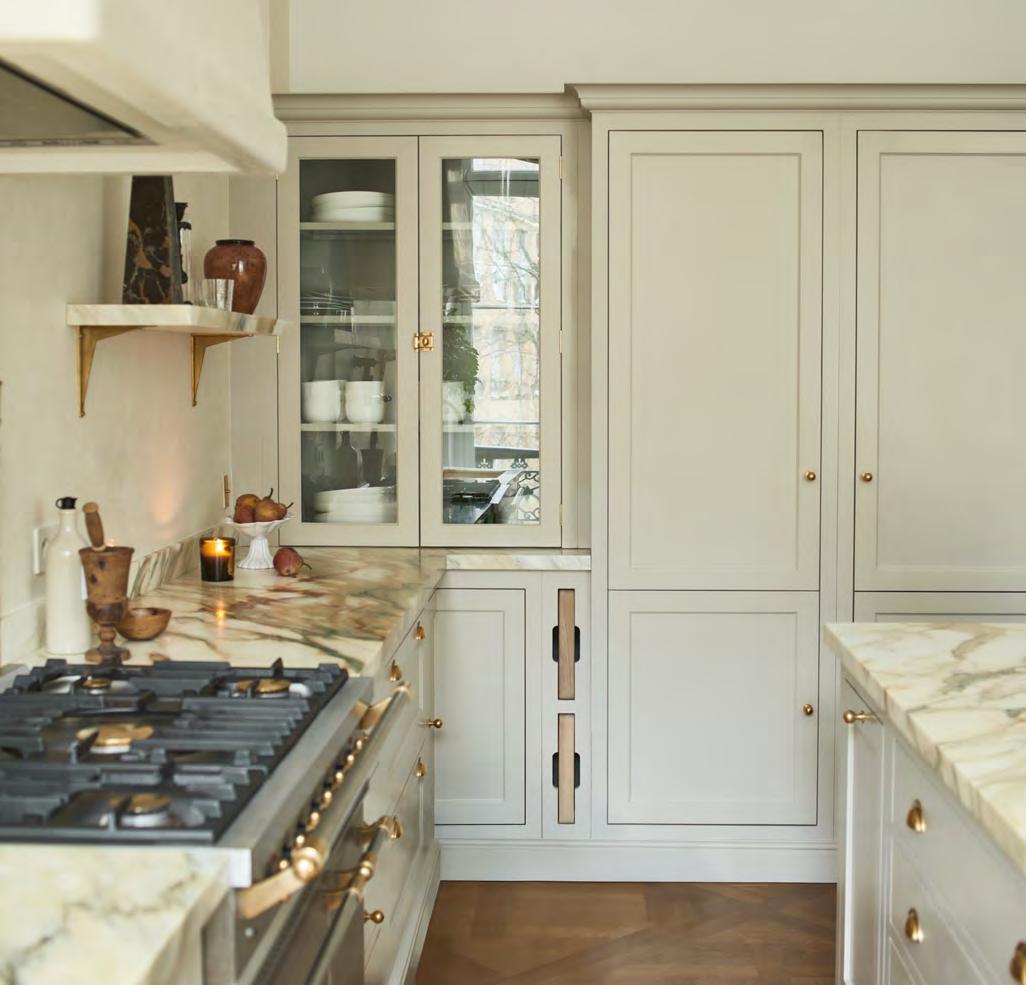
What makes a design last generations? Is it exceptional craftsmanship? Is it honest materials? Is it timeless design? For us, it’s all of these. That’s what makes a Neptune home.
